Trip Report
Costa Rica
Hummingbirds and Wildlife
Photo Tour
2015

This was our third Photo Tour to Costa Rica, a foreign country that is easy to get to, safe, and extremely diverse in its photography subjects. Each time I travel to Costa Rica I regret that I didn't devote more time for exploration and to check out new areas, and of course that was the same for this trip.
Fortunately, for this tour we did add on a final destination, which we visited on our first scouting trip and first tour, and it was a real success. Although we only had a day and a half at the location it was, for many, one of their favorite spots.
I did the trip with Greg Basco from PhotoVerde Tours. Greg is from the US but did his Peace Corp work in Costa Rica, and eventually married and settled here. Having Greg, and his bus driver and assistant, José, was a real plus for the trip, as Greg knows the country intimately, and José has unbelievable eyes for spotting subjects.
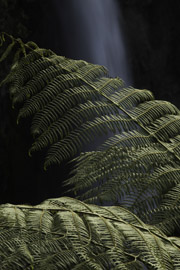
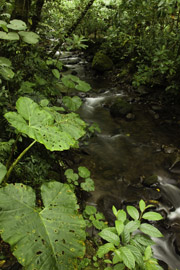
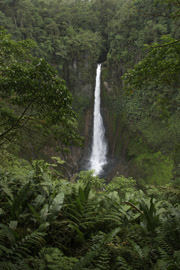
For those who did the trip, the locations esoterically referred to below are known. However, for others, I apologize for the mystery of 'Location One,' etc., because Greg has put a lot of time into finding these locations and he, and I agree here, would rather keep that private. Too often, unfortunately, a few unscrupulous tour operators simply pirate an itinerary. Having never been there themselves, they use a brochure or a trip report for their background. I think clients really suffer when this happens, and it is unfair to everyone, except the pirate, involved.
On the trip I used the new Canon 7D Mark II that Mary, and then I, used in Chile for the puma shoot. While I appreciated the 1.6X crop factor, which made making bird shots a lot easier, I wasn't too impressed with the camera. In Chile, when we photographed puma, Mary's camera focused beyond the subject. I did fix that by doing a rather significant micro-adjustment with the camera. However, one of the features that was rumored to be an improvement was the higher ISO, but I found that ISOs at or above 1600 lacked the crispness of the Mark IV or 1DX. In fact, I didn't think that the camera really offered super crisp images, compared to those two other cameras.
Admittedly, I did not do a real definitive test, and perhaps I am wrong. However, my gut-feeling was such that I used my DX whenever I needed a high ISO. I felt much more comfortable with that camera.
On the positive side, the focusing grid covers a much larger area of the viewfinder (because of the 1.6X crop factor) so scrolling the focusing point to an off-center subject was more convenient. With my 1DX, I often have to move the camera after first locking an AF point, since there is still a lot of viewfinder empty space.
On the negative, I cannot understand why Canon has not linked an active AF point with the spot-metering. I know that would make it even closer to the 1DX and other pro cameras, and this might hurt sales, but on the other hand, I suspect they are marketing the 7D Mark II as a backup to the pro cameras. If that is the case, then they fail, as this induces confusion. I did get used to simply center metering, with a spot-meter, but I did not like it.
Mary asked me if I thought we wasted money purchasing the 7D. I said no, since it is light weight, and if you can live within the limitations, it's an OK back-up. But we're not rushing out to buy a second!
I carried my gear in our Gura Gear Bataflae bags, which are light weight and very water resistant, and extremely durable. I used our Wimberley Gimbal Heads with my long lenses, and a Really Right Stuff BH40 for our landscape work. This year I mounted my heads on the following RRS clamps and plates:
TA-LBC: Round lever-release clamp
Round lever-release style quick-release clamp
TH-DVTL-55: Round Dovetail Plate
Round Dovetail Plate
TH-DVTL-40: Round Dovetail Plate
Round Dovetail Plate
This allowed me to quickly switch from our Wimberley to our BH40 without having to unscrew the heads. With the TA-LBC a simple move with the clamp and I had one head off, and a second later the other head on. This is a huge time-saver but also lessens the chance of stripping the 3/8th bolt of the tripod.
Both Mary and I, and most of our participants, use Hoodman CF cards. I was using 64gb cards, and using the firmware upgrade for their Steel 3.0 card reader I could download a full card in only a few minutes. The Hoodman cards have never failed me!
Here's the trip report, written at the conclusion of each day.
Day 1. San Jose.
We met at 6:30PM for a meet and greet and introductions, including Greg Basco who joined us for a brief orientation. Nearly everyone had arrived a day or two earlier, to avoid possible airport delays, and fortunately the weather for all of us was favorable, and no one endured a delay. Today, as well as the preceding two days, San Jose had been very windy, so much so that photography was impractical.
The grounds of our hotel, which in the past was good for Blue-crowned Mot-Mots, seemed more manicured and smaller, and I only saw one bird, which was skittish and unapproachable. We had dinner as a group and an early night, for a big day tomorrow.
Day 2. San Jose to our first Lodge
We had breakfast at 7, followed by a Power Point presentation I gave on our subjects, and how we would be using flash. Coincidentally, that evening Greg did a follow-up program on flash that went into greater depth, a nice reinforcement for what we covered during my program and on-site, when we arrived at our lodge.
In contrast to many trips here, today our drive was under clear blue skies and the Pasao Volcano, the second largest active volcano in CR, were spectacular. The ash-covered caldera and slopes were clearly visible, an alien, Spartan gray. We crossed high country, mostly mixed forests and pastureland, and descended a winding switch-back to reach our lodge, approaching it from the direction we’re normally leaving from. Descending into the valley, with our lodge flanked by the protected forests of two adjacent national parks, was spectacular.
We had lunch, and I set up a flash set-up and tube feeders, while Greg placed two dish feeders at the position where we’ll have our stations tomorrow. Birds visited almost immediately, but through the day they tapered off. I stayed at my set-up about an hour to test lights and flashes, and the action was rather slow. Half way through the time I took down the other feeders but the results were not much better. Still, I got my test shots done and confirmed that everything was working fine.
 Afterwards, I headed into the forest to explore. Although species diversity is high, a jungle can seem surprisingly empty. Plant life, of course, is riotous, with bromeliads, orchids, and what looked like parasitic palms lining branches and tree trunks. I heard a few birds and saw two, a guan and a flycatcher, and one spider, a colorful, rainbow-hued little spider with enlarged front legs reminding me of a crab. I wasn’t carrying gear and almost turned back to get my macro equipment but instead I continued up the trail, exploring. It was approaching 5PM and a light rain and heavy cloud cover had dropped the light level to dusk-like conditions so I headed back, looking for the spider I’d seen earlier. It was gone. Coatimundis and Black Guans were at the feeder as I passed, with the raccoon-like Coati watching me intently but holding its ground. After dinner, by the light of a flashlight, I saw a Pacca at the feeder, but I’ve shot that species before in a bit more favorable conditions. Tomorrow the group starts shooting the hummers.
Afterwards, I headed into the forest to explore. Although species diversity is high, a jungle can seem surprisingly empty. Plant life, of course, is riotous, with bromeliads, orchids, and what looked like parasitic palms lining branches and tree trunks. I heard a few birds and saw two, a guan and a flycatcher, and one spider, a colorful, rainbow-hued little spider with enlarged front legs reminding me of a crab. I wasn’t carrying gear and almost turned back to get my macro equipment but instead I continued up the trail, exploring. It was approaching 5PM and a light rain and heavy cloud cover had dropped the light level to dusk-like conditions so I headed back, looking for the spider I’d seen earlier. It was gone. Coatimundis and Black Guans were at the feeder as I passed, with the raccoon-like Coati watching me intently but holding its ground. After dinner, by the light of a flashlight, I saw a Pacca at the feeder, but I’ve shot that species before in a bit more favorable conditions. Tomorrow the group starts shooting the hummers.
Day 3. Our first lodge
I started setting up around 6:30, although the group would not start shooting until 8:50, with everyone getting at least three sessions in at the three different sets. The situation looked a bit bleak when I started, as few birds came to our feeders and, indeed, few seemed to be about. However, by delaying our start the birds had a chance to find and use the feeder, and from that point on the shooting was extremely good.

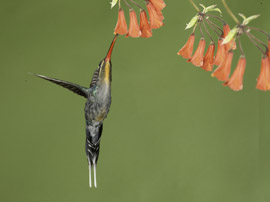
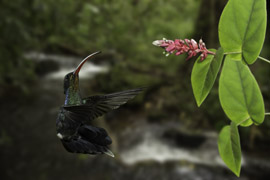

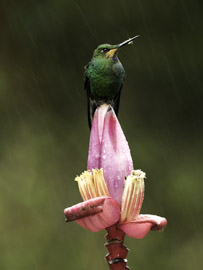
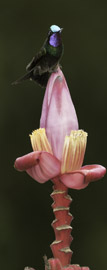
It began to rain in the early afternoon and a banana flower we’d placed out earlier, for natural light/fill flash shooting, was an interesting subject once the rains began. Several species of hummingbirds visited the feeder, and by experimenting with different shutter speeds I could see the effect I’d get with streaking rain. I may like 1/100th best, but I haven’t checked for sharpness yet, and at that relatively slow speed the hummingbirds might be blurred from subject movement.
The group shot until 4:10 when it was quite dark under the pavilion where we had set up. I went onto the set I brought for a half hour, which gave me some shooting. If my results are anywhere near that that the group should have had, they should be extremely happy. In all, we had about six species visiting the feeders, and this year, for the first time, Green Hermits, a relatively larger hummer with a long tail and deeply decurved bill, were reasonably frequent visitors to the feeders.
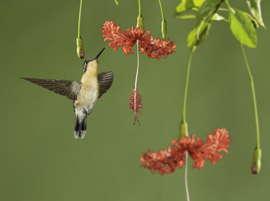
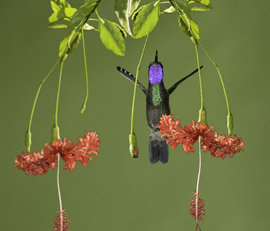
We did not have a program this evening, giving everyone a chance to look at their images in order to make adjustments for tomorrow. Most folks were tired, anyway.
Day 4. First Lodge, New Location for Hummer shoot
We left at 8AM to visit another location where we would spend the day photographing hummingbirds, jungle landscapes, and waterfalls. By 9:30 we were set up and the first two shooters were going, and almost immediately birds hit the feeders. The action continued throughout the day, only slowing at around 4:15, about 15 minutes before we were scheduled to quit. With the bird activity suddenly stopping we packed up and returned to our lodge by 5:15.
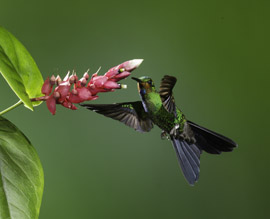

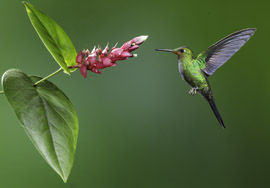 We had about eight species, including the Green Hermits, Violet Saberwings, and several new species I still have to identify. After two consecutive years in Ecuador I must admit I’m rusty on the CR hummingbird names and I must rely on my book, and not memory, for identification.
We had about eight species, including the Green Hermits, Violet Saberwings, and several new species I still have to identify. After two consecutive years in Ecuador I must admit I’m rusty on the CR hummingbird names and I must rely on my book, and not memory, for identification.
In addition to the hummingbirds folks shot flowers and landscapes, butterflies, and squirrels. I challenged myself with a 7D with a 1.6X crop factor, 100mm macro, and extension tubes and 1.4X tele-converter and chased after tiny jumping spiders, ants, and the spermatophores of mosses. I went for two long walks through the forest, really searching for hidden macro subjects. On the first walk I did not see an ant or a spider, the most likely critters to see, and only saw 3 birds and heard birds 6-7 times. Species diversity is high, but numbers are low in the jungle, and by the insect-damaged vegetation, I suspect most activity occurs at night. During the day, if I could see something, no doubt a bird could, too, and would eat whatever it saw. Aside from a few tiny moths, gnats, and a leafhopper, I saw nothing else on the jungle walk. Amazing.
Last night fierce winds and heavy rains swept through our canyon, and today, at our new location, the weather alternated between sunshine (rare), overcast, and occasional light to heavy showers. As I write this the rain has begun again, along with the wind, and the tree sway violently amidst the gusts.
Day 5. First Lodge to Second Lodge, near the Nicaraguan border.
Shortly after doing last night’s trip report the power went off, and remained so throughout the night and into the morning, so we packed and ate breakfast in the dark. We left at 7:30 for our drive North, stopping en route at a ranch where we photographed Scarlet and Great Green Macaws. We tried getting shots of the macaws as they flew back and forth, going for the peanuts that the owner provided. I was using my DX and somehow the camera was set on medium JPG, so I was a bit disappointed . We had a great lunch at the ranch, then continued on to our second lodge.
We arrived at 3, and I immediately set up for the Pallas Long-tongued Bats 100 yards into the forest. The group, under Greg’s guidance, shot birds at the porch, with perhaps the highlight being the Golden-hooded Tanagers, little Indigo Bunting-sized birds, and extremely colorful.
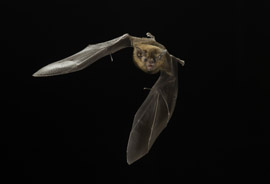
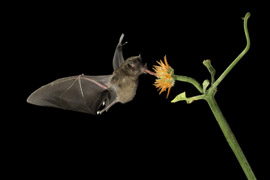
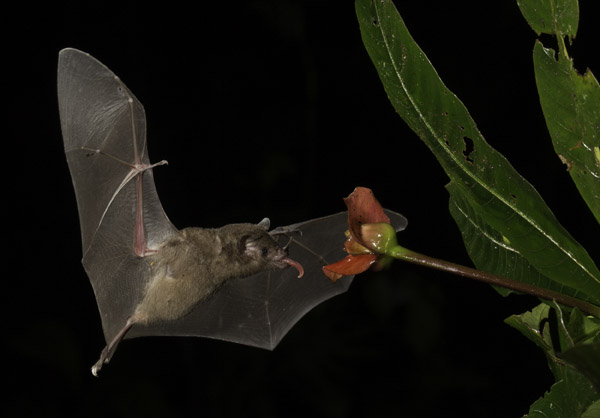
Pallas Long-tongued Bats shot when a RangeIR triggered the flashes. Everyone got shots like this -- either with a flower, which I did late on the second night because I wasn't sure it would be productive, or without a flower -- where dynamic poses were common. The techniques used will be taught again in the summer of 2015 at our Advanced Flash Nature Photo Course.
I did a hard-wired Nikon system and everything worked, and the set-up went rather quickly. At 5 I took the photographers in so that we could set up in the light, since doing this can be confusing regardless of the time of day. I think everyone got ready, and as I write this, we’re soon to head back into the forest to turn on the gear and hope for the best.
There has been a lot of rain, and the trail was flooded, with the wooden walkway partially under water. Insects, at this time, haven’t been bad, but the humidity is atrocious. My room, like all the others, is like a sauna.
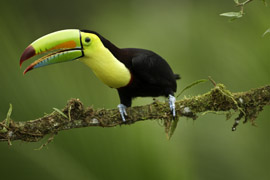 Day 6. Second Lodge
Day 6. Second Lodge
The bat photography was successful, and all seven of the eight shooters photographed the bats. One did not – recovering from a medical issue that person wisely chose to stay out of the jungle and the potential insect bites. We shot about 500 images each and the shoot went well.
The weather cooperated in the morning and everyone assembled some time before 6AM for the Toucans, Parrots, Parakeets, and Honeycreepers that come to the feeders. Black-whiskered Woodpeckers, beautiful Golden Hooded Tanagers, Great Currasows, and White-nosed Coatimundis were common. The Tanagers and Euphonias were especially cooperative.
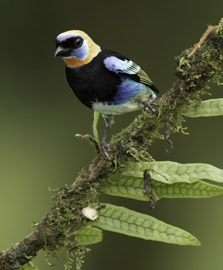
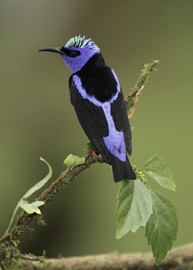
Golden-hooded Tanager; Red-legged honeycreeper
Mid-morning Greg and I headed to the manager’s house to set up the Honeycreepr and the hummingbird shoots for that afternoon. When I arrived honeycreepers were in abundance. The Hummers – Long-billed Hermit, Rufous-tailed, and Jacobins – took a long time to come to our feeders but eventually they did and we did some test shots.
After lunch, I headed back into the jungle to set up the bat shoot for the evening. I also tried a set for False Vampire Bats, or whatever the species is that eats frogs. One group of 4 went to the manager’s house, which had mixed results. The hummers were now so abundant at the feeder that Greg had to put a second feeder nearby to lure some of the birds from the shooting set. A hawk flew by and spooked the honeycreepers, so the action there was slow, and compounded by a group of Aracaris that came in and dominated the feeder.
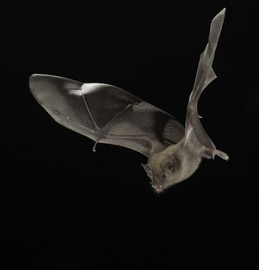 That evening six shooters did the bats and we had even better success. It rained before, and often during the shoot, but we were under cover and dry. At times the heavy rains repressed the birds, but still the shooting was good. I had some flowers that I tried at the end, not knowing whether that would work or not. Two shooters remained for that, with one staying until his card ran out. Soon afterwards, my battery died and I was finished, too. Having shot about 3,000 frames on the bats! Many, of course, will be black.
That evening six shooters did the bats and we had even better success. It rained before, and often during the shoot, but we were under cover and dry. At times the heavy rains repressed the birds, but still the shooting was good. I had some flowers that I tried at the end, not knowing whether that would work or not. Two shooters remained for that, with one staying until his card ran out. Soon afterwards, my battery died and I was finished, too. Having shot about 3,000 frames on the bats! Many, of course, will be black.
Prior to dinner the power went out, just as it had at our first lodge, and when I returned at 10:30 I had a cold shower and set out my very wet gear to dry overnight. Around 2AM the power returned.
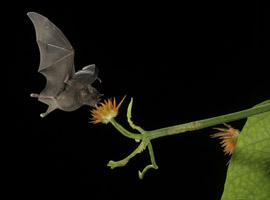
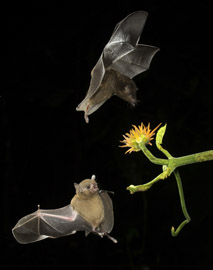
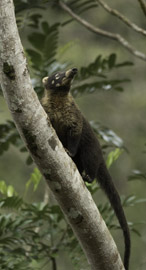 Day 7. Second Lodge.
Day 7. Second Lodge.
Again, everyone assembled at the porches for the birds, although some slept in and did not arrive until breakfast. After breakfast the remaining 4 went to the manager’s house to shoot, and had more success than the previous group. Or, they were simply more optimistic.
After lunch, 6 of us took a boat ride along the nearby river, eventually reaching the Nicaraguan border. Other tourists, earlier in the day, had great American Crocodiles, and we were hoping to photograph them. When we got on the river it rained, and remained relatively cool through the day, and we only saw one small croc. Later I talked with the tourist I’d spoken to earlier, and his croc was 4-5 meters, and in the open.
Still, it was a refreshing change, with Green and Amazon Kingfishers, Little Blue and Great Blue Herons, Great, Snowy, and Cattle Egrets, Anhingas, Linneated Tiger-herons, Green Tree Iguanas, Plumed Basilisk Lizards, Collared Forest Falcon, Gray Hawk, and of course the croc. Everyone enjoyed it as a change from the porch and bird shooting, although the few that remained behind did have wonderful light once the rain passed, and had great opportunities with Chestnut-mandible Toucans, Currasows, and other birds.
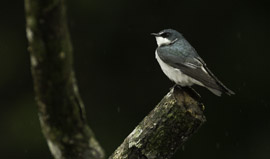
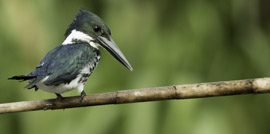
Mangrove Swallow: Amazon Kingfisher
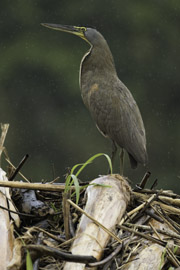 Ironically, Just as we were about to leave for the boat trip, my friend from the crocs reported he’d just returned from the King Vulture blind and showed me a great shot, taken with his I-Phone. José, one of our guides, headed there, but the rest elected to stay with the boat trip. When José arrived the bird flew off – so our group made the right choice.
Ironically, Just as we were about to leave for the boat trip, my friend from the crocs reported he’d just returned from the King Vulture blind and showed me a great shot, taken with his I-Phone. José, one of our guides, headed there, but the rest elected to stay with the boat trip. When José arrived the bird flew off – so our group made the right choice.
No bats tonight – although it doesn’t look as if a storm would occur, but the evening was spent repacking all the gear necessary for that shoot. A monumental job.
Day 8 to the Third Lodge
We left our lodge at 7, stopping along the way at a small wildlife refuge where Boat-billed Herons nest, and where we’ve often had sloths, mot-mots, and other subjects. We only had 2.5 hours there – I could spend all day slowly working the location, but as it was we
didn’t arrive at our third destination until 4PM.
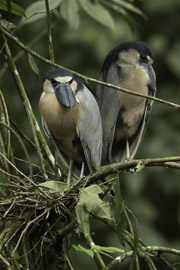
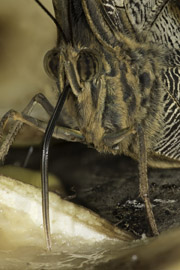

The refuge was productive, and the Boat-billed Herons were the best I’ve ever had there, with one pair nesting close to a viewing area in the open. Good shooting. I did some Helicon Focus shots of Blue Morpho Butterflies, and I was amazed, that evening, when HF put the images together in seconds – and they were great. It inspired me to do more on this trip.
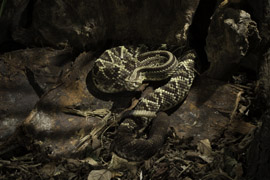
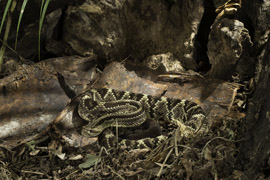
Cascabel or Tropical Rattlesnake
Day 9 and 10. Third Lodge and the Reptile Zoo
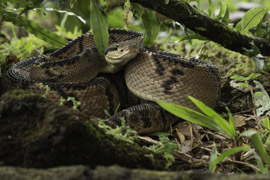 The scenic vistas and potential birds potentially available at our third lodge were non-existent, as heavy cloud cover, intermittent heavy rain squalls, and fog eliminated those chances on both days. In the past, in this, the dry season, we’d shoot hummers in the gardens, and Oropendolas, Guans, and Tanagers at the feeders, but not this year.
The scenic vistas and potential birds potentially available at our third lodge were non-existent, as heavy cloud cover, intermittent heavy rain squalls, and fog eliminated those chances on both days. In the past, in this, the dry season, we’d shoot hummers in the gardens, and Oropendolas, Guans, and Tanagers at the feeders, but not this year.
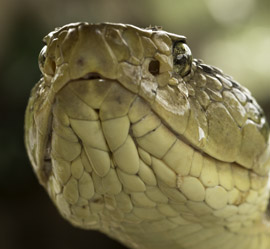

Fer-de-Lance; Short-nosed Vine Snake
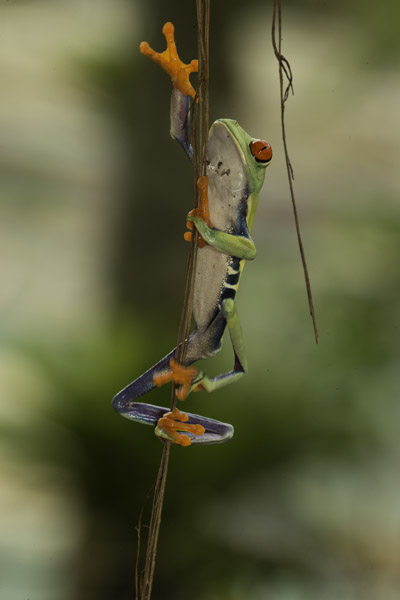
Red-eyed Treefrog
Nevertheless, it was perfect weather for a Reptile Shoot at a zoo where Greg has established a relationship. I’ve been here three times, and I’m good friends with the owner, too, ever since bringing along a snake stick and handling the Bushmasters and Fer-de-Lance snakes on the first shoot. He knows I’m a reptile guy, too.
The shoots were extremely productive. Each day we left our lodge at 9, arriving about 30 minutes later, and beginning the shoot around 10 or 10:30, giving us time to set up the sets or flashes. We shot about 20 different Costa Ricans herptiles, including everyone’s favorite, the Red-Eyed Treefrog, and concluding on our second day with a real highlight, a Bushmaster, the largest pit-viper in the world, and one of the largest venomous snakes in the world as well. This thick, boa-looking snake can easily grow to 12 feet.
We shot Fer-de-Lances, including one freshly captured specimen that at one point struck at me, lunging half off the table in doing so, but I was well out of reach. Still, the owner of the zoo and I both jumped back in recoil. Jumping Pit-Vipers, Godman's Pit-Viper, Cascabel or Tropical Rattlesnake, Hognose Viper, Poison Dart Frogs, various Toads, and Green Tree Anoles, Helmeted Iguanas, and Pug-nosed Anoles were a few of our other subjects.
We concluded around 4 each day, returning to the lodge by 5 for an early dinner and bed.

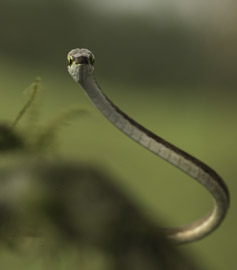
Casque-headed Lizard; Brown Vine Snake
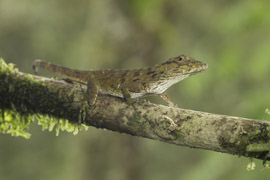

Green Tree Anole; Blunt-headed Tree Snake
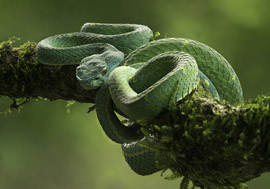

Striped Palm Viper with Helicon Focus, 16 images; Eyelash Viper

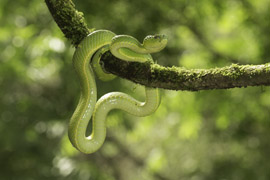
Jumping Pit-Viper; Striped Palm Viper
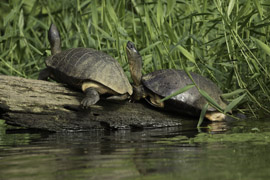 Day 11. Our Final Destination
Day 11. Our Final Destination
We left at 5:50 for a 5-6 drive to the coast and our last destination. At 2:30 we did a 3 hour boat ride to photograph Capuchin Monkeys, Anhingas, several Heron species, Jacanas, Gallinules, Basilisk Lizards, Tree Iguanas – the males bobbing their raised head and wagging their prominent orange dewlap, obviously in a territorial or courtship display, and Caimans.
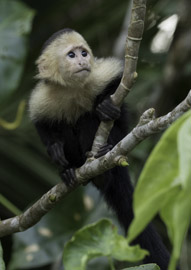
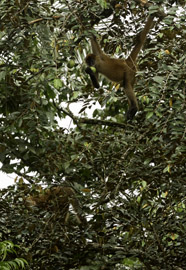
 The Capuchins were accompanied by a few Spider Monkeys, but they disappeared rather quickly into the forest. The Capuchins did not, and stayed along the waterway giving us about 15 minutes of very hectic, very taxing shooting, but I think we came away with some decent images. But it was tough – at least for me, using a monopod and a 200-400. At times I wished I’d have had my 70-300 instead, and at the end I switched from my new 7D Mark II to my DX, and I must say I like everything about the DX much more, from the focus, to the exposure-linked to AF point, to the point selection in AF. I am not sold on the 7D in terms of image quality, although the 1.6X mag is a bonus at times.
The Capuchins were accompanied by a few Spider Monkeys, but they disappeared rather quickly into the forest. The Capuchins did not, and stayed along the waterway giving us about 15 minutes of very hectic, very taxing shooting, but I think we came away with some decent images. But it was tough – at least for me, using a monopod and a 200-400. At times I wished I’d have had my 70-300 instead, and at the end I switched from my new 7D Mark II to my DX, and I must say I like everything about the DX much more, from the focus, to the exposure-linked to AF point, to the point selection in AF. I am not sold on the 7D in terms of image quality, although the 1.6X mag is a bonus at times.
At dinner, a related species to the Red-eyed Treefrog (a look-alike) was on a palm frond nearby, but with an early start today, at a 5:45 departure tomorrow, no one had the energy or ambition to shoot the frog. Leaf-cutting Ants parade close to my room during the day, and hopefully tomorrow I’ll shoot this, the epitome of a Super Organism, a species that each individual works as a collective part, functioning, really, to nourish and tend the whole, not the individual itself. Hence Super Organism, and this species is the largest of them all – millions may make up a colony.
 Day 12. Our Final Destination
Day 12. Our Final Destination
It rained throughout the night, sometimes in a torrential, tropical downpour, with the rain slapping hard upon the roof of our cabin. We were supposed to do a boat ride at 5:45AM, the early shift, and return for a mid-morning breakfast, but the rain and thick overcast made shooting impossible. We rescheduled for 8:30, when we had decent light but still had rain, which we could now deal with a boat that had a roof, giving us protection.
Because of the size of the boat we stayed in the main waterway, but the shooting was good, with displaying Tree Iguanas, several Plumed Basilisk lizards, Tiger Herons, Little Blue, Snowy and Great Egrets, and Anhingas.
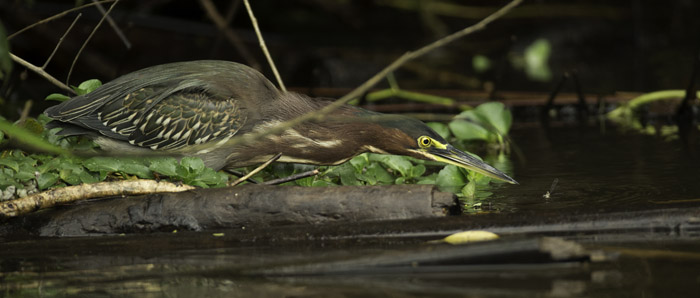
One Green-backed Heron was notable – something I do not think I’ve ever seen before. The Heron was fishing, using a captured Damselfly as bait. The heron would extend its neck forward and drop the damselfly, hoping that the insect would draw in a fish. When the bait drifted too far, the heron plucked it back out, only to repeat the process several times. I may have seen this, once, in Florida – but this was the first time I had a great, LONG, look, and photographed it, too. Unfortunately a fish grabbed the bug and the Heron missed, ending the show.
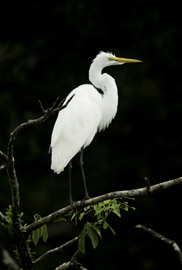
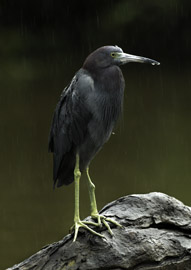
A Great Egret and a Little Blue Heron. Both could be challenging for an exposure, especially on an aperture-priority mode. On manual mode, it is easy -- and it is what we teach on our Complete Nature Photo Course. I wish everyone who did one of our trips took that course!
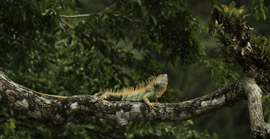 PM. It rained again, and we used a covered boat once more. We repeated the same subjects, although in the afternoon we had a Tiger-Heron nest, and a bedraggled, sopping wet Two-Toed Sloth in a tree. At 4:35 we finished, so that at 5:30 I could demonstrate adding a flower to the hummer photos, although that was delayed as still another torrential rain hammered down. Frogs of some unknown species were calling near our cabins, but without getting into the water myself I couldn’t determine the species.
PM. It rained again, and we used a covered boat once more. We repeated the same subjects, although in the afternoon we had a Tiger-Heron nest, and a bedraggled, sopping wet Two-Toed Sloth in a tree. At 4:35 we finished, so that at 5:30 I could demonstrate adding a flower to the hummer photos, although that was delayed as still another torrential rain hammered down. Frogs of some unknown species were calling near our cabins, but without getting into the water myself I couldn’t determine the species.
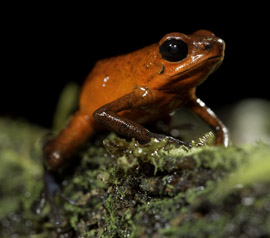 Day 13. Returning to San Jose
Day 13. Returning to San Jose
It rained throughout the night. At 4AM it was raining so
hard that I had to get up and look outside to see exactly what a rain storm of that magnitude looked like. I was tempted to step outside and feel it, but that would have jolted me awake and I still had two hours before I needed to get up.
Miraculously, the skies cleared when the porters came to transport our luggage to the boat dock, saving our suitcases and duffels from a definite soaking. That luck repeated itself when we reached the dock where we met José and the bus, and again we had dry weather. On the 45 minute boat ride to that dock, and once we started driving, we had rain, so we were indeed very, very lucky.
The river must have risen two or three feet, and as we motored to the mainland we passed flooded forests, pastures, and homes. A large American Crocodile was lying on a bank in a sheltered lagoon, but we did not have one near us along the river as we did on the way in, when no one had a camera out for a shot. We expected to see more, but had only seen caimans on our boat rides.
Ironically, a very large female Plumed Basilisk Lizard was pressed against a vertical tree trunk quite close to the main walkway through our camp. A few tourists were shooting it, at a distance of 3 feet or less. On my previous trip here I’d seen several good males, but we saw none this trip, except on our boat excursions.
At lunch I found three Three-toed Sloths, and one looked active, but by the time I got my camera – 5 minutes or less – the sloth had gone into its sleeping huddle and the shot was lost. Tim showed me the shot he made at the wildlife center 8 or so days ago – an absolute killer, with the face visible and hanging in full view, full-frame. Beautiful!
We reached our hotel by 2 and everyone repacked for the trip home tomorrow. At 5:30 we met for a final review of images and identifications, and a farewell dinner before adjourning for the night.
In 2016 we may be returning to Costa Rica -- as I post this our schedule is still being planned. If not, in 2017 we will definitely be there, and in addition to the locations and subjects shown here we'll also be visiting the Oso Peninsula, the wildest, most wildlife rich area in Costa Rica. Monkeys, sloths, reptiles, birds ... the new location should add a whole new wonderful dimension to the tour!
Contact our office IMMEDIATELY to get on our first contact list.
Trip Report
Costa Rica
Hummingbirds and Wildlife
Photo Tour
2015

This was our third Photo Tour to Costa Rica, a foreign country that is easy to get to, safe, and extremely diverse in its photography subjects. Each time I travel to Costa Rica I regret that I didn't devote more time for exploration and to check out new areas, and of course that was the same for this trip.
Fortunately, for this tour we did add on a final destination, which we visited on our first scouting trip and first tour, and it was a real success. Although we only had a day and a half at the location it was, for many, one of their favorite spots.
I did the trip with Greg Basco from PhotoVerde Tours. Greg is from the US but did his Peace Corp work in Costa Rica, and eventually married and settled here. Having Greg, and his bus driver and assistant, José, was a real plus for the trip, as Greg knows the country intimately, and José has unbelievable eyes for spotting subjects.



For those who did the trip, the locations esoterically referred to below are known. However, for others, I apologize for the mystery of 'Location One,' etc., because Greg has put a lot of time into finding these locations and he, and I agree here, would rather keep that private. Too often, unfortunately, a few unscrupulous tour operators simply pirate an itinerary. Having never been there themselves, they use a brochure or a trip report for their background. I think clients really suffer when this happens, and it is unfair to everyone, except the pirate, involved.
On the trip I used the new Canon 7D Mark II that Mary, and then I, used in Chile for the puma shoot. While I appreciated the 1.6X crop factor, which made making bird shots a lot easier, I wasn't too impressed with the camera. In Chile, when we photographed puma, Mary's camera focused beyond the subject. I did fix that by doing a rather significant micro-adjustment with the camera. However, one of the features that was rumored to be an improvement was the higher ISO, but I found that ISOs at or above 1600 lacked the crispness of the Mark IV or 1DX. In fact, I didn't think that the camera really offered super crisp images, compared to those two other cameras.
Admittedly, I did not do a real definitive test, and perhaps I am wrong. However, my gut-feeling was such that I used my DX whenever I needed a high ISO. I felt much more comfortable with that camera.
On the positive side, the focusing grid covers a much larger area of the viewfinder (because of the 1.6X crop factor) so scrolling the focusing point to an off-center subject was more convenient. With my 1DX, I often have to move the camera after first locking an AF point, since there is still a lot of viewfinder empty space.
On the negative, I cannot understand why Canon has not linked an active AF point with the spot-metering. I know that would make it even closer to the 1DX and other pro cameras, and this might hurt sales, but on the other hand, I suspect they are marketing the 7D Mark II as a backup to the pro cameras. If that is the case, then they fail, as this induces confusion. I did get used to simply center metering, with a spot-meter, but I did not like it.
Mary asked me if I thought we wasted money purchasing the 7D. I said no, since it is light weight, and if you can live within the limitations, it's an OK back-up. But we're not rushing out to buy a second!
I carried my gear in our Gura Gear Bataflae bags, which are light weight and very water resistant, and extremely durable. I used our Wimberley Gimbal Heads with my long lenses, and a Really Right Stuff BH40 for our landscape work. This year I mounted my heads on the following RRS clamps and plates:
TA-LBC: Round lever-release clamp
Round lever-release style quick-release clamp
TH-DVTL-55: Round Dovetail Plate
Round Dovetail Plate
TH-DVTL-40: Round Dovetail Plate
Round Dovetail Plate
This allowed me to quickly switch from our Wimberley to our BH40 without having to unscrew the heads. With the TA-LBC a simple move with the clamp and I had one head off, and a second later the other head on. This is a huge time-saver but also lessens the chance of stripping the 3/8th bolt of the tripod.
Both Mary and I, and most of our participants, use Hoodman CF cards. I was using 64gb cards, and using the firmware upgrade for their Steel 3.0 card reader I could download a full card in only a few minutes. The Hoodman cards have never failed me!
Here's the trip report, written at the conclusion of each day.
Day 1. San Jose.
We met at 6:30PM for a meet and greet and introductions, including Greg Basco who joined us for a brief orientation. Nearly everyone had arrived a day or two earlier, to avoid possible airport delays, and fortunately the weather for all of us was favorable, and no one endured a delay. Today, as well as the preceding two days, San Jose had been very windy, so much so that photography was impractical.
The grounds of our hotel, which in the past was good for Blue-crowned Mot-Mots, seemed more manicured and smaller, and I only saw one bird, which was skittish and unapproachable. We had dinner as a group and an early night, for a big day tomorrow.
Day 2. San Jose to our first Lodge
We had breakfast at 7, followed by a Power Point presentation I gave on our subjects, and how we would be using flash. Coincidentally, that evening Greg did a follow-up program on flash that went into greater depth, a nice reinforcement for what we covered during my program and on-site, when we arrived at our lodge.
In contrast to many trips here, today our drive was under clear blue skies and the Pasao Volcano, the second largest active volcano in CR, were spectacular. The ash-covered caldera and slopes were clearly visible, an alien, Spartan gray. We crossed high country, mostly mixed forests and pastureland, and descended a winding switch-back to reach our lodge, approaching it from the direction we’re normally leaving from. Descending into the valley, with our lodge flanked by the protected forests of two adjacent national parks, was spectacular.
We had lunch, and I set up a flash set-up and tube feeders, while Greg placed two dish feeders at the position where we’ll have our stations tomorrow. Birds visited almost immediately, but through the day they tapered off. I stayed at my set-up about an hour to test lights and flashes, and the action was rather slow. Half way through the time I took down the other feeders but the results were not much better. Still, I got my test shots done and confirmed that everything was working fine.
 Afterwards, I headed into the forest to explore. Although species diversity is high, a jungle can seem surprisingly empty. Plant life, of course, is riotous, with bromeliads, orchids, and what looked like parasitic palms lining branches and tree trunks. I heard a few birds and saw two, a guan and a flycatcher, and one spider, a colorful, rainbow-hued little spider with enlarged front legs reminding me of a crab. I wasn’t carrying gear and almost turned back to get my macro equipment but instead I continued up the trail, exploring. It was approaching 5PM and a light rain and heavy cloud cover had dropped the light level to dusk-like conditions so I headed back, looking for the spider I’d seen earlier. It was gone. Coatimundis and Black Guans were at the feeder as I passed, with the raccoon-like Coati watching me intently but holding its ground. After dinner, by the light of a flashlight, I saw a Pacca at the feeder, but I’ve shot that species before in a bit more favorable conditions. Tomorrow the group starts shooting the hummers.
Afterwards, I headed into the forest to explore. Although species diversity is high, a jungle can seem surprisingly empty. Plant life, of course, is riotous, with bromeliads, orchids, and what looked like parasitic palms lining branches and tree trunks. I heard a few birds and saw two, a guan and a flycatcher, and one spider, a colorful, rainbow-hued little spider with enlarged front legs reminding me of a crab. I wasn’t carrying gear and almost turned back to get my macro equipment but instead I continued up the trail, exploring. It was approaching 5PM and a light rain and heavy cloud cover had dropped the light level to dusk-like conditions so I headed back, looking for the spider I’d seen earlier. It was gone. Coatimundis and Black Guans were at the feeder as I passed, with the raccoon-like Coati watching me intently but holding its ground. After dinner, by the light of a flashlight, I saw a Pacca at the feeder, but I’ve shot that species before in a bit more favorable conditions. Tomorrow the group starts shooting the hummers.
Day 3. Our first lodge
I started setting up around 6:30, although the group would not start shooting until 8:50, with everyone getting at least three sessions in at the three different sets. The situation looked a bit bleak when I started, as few birds came to our feeders and, indeed, few seemed to be about. However, by delaying our start the birds had a chance to find and use the feeder, and from that point on the shooting was extremely good.






It began to rain in the early afternoon and a banana flower we’d placed out earlier, for natural light/fill flash shooting, was an interesting subject once the rains began. Several species of hummingbirds visited the feeder, and by experimenting with different shutter speeds I could see the effect I’d get with streaking rain. I may like 1/100th best, but I haven’t checked for sharpness yet, and at that relatively slow speed the hummingbirds might be blurred from subject movement.
The group shot until 4:10 when it was quite dark under the pavilion where we had set up. I went onto the set I brought for a half hour, which gave me some shooting. If my results are anywhere near that that the group should have had, they should be extremely happy. In all, we had about six species visiting the feeders, and this year, for the first time, Green Hermits, a relatively larger hummer with a long tail and deeply decurved bill, were reasonably frequent visitors to the feeders.


We did not have a program this evening, giving everyone a chance to look at their images in order to make adjustments for tomorrow. Most folks were tired, anyway.
Day 4. First Lodge, New Location for Hummer shoot
We left at 8AM to visit another location where we would spend the day photographing hummingbirds, jungle landscapes, and waterfalls. By 9:30 we were set up and the first two shooters were going, and almost immediately birds hit the feeders. The action continued throughout the day, only slowing at around 4:15, about 15 minutes before we were scheduled to quit. With the bird activity suddenly stopping we packed up and returned to our lodge by 5:15.


 We had about eight species, including the Green Hermits, Violet Saberwings, and several new species I still have to identify. After two consecutive years in Ecuador I must admit I’m rusty on the CR hummingbird names and I must rely on my book, and not memory, for identification.
We had about eight species, including the Green Hermits, Violet Saberwings, and several new species I still have to identify. After two consecutive years in Ecuador I must admit I’m rusty on the CR hummingbird names and I must rely on my book, and not memory, for identification.
In addition to the hummingbirds folks shot flowers and landscapes, butterflies, and squirrels. I challenged myself with a 7D with a 1.6X crop factor, 100mm macro, and extension tubes and 1.4X tele-converter and chased after tiny jumping spiders, ants, and the spermatophores of mosses. I went for two long walks through the forest, really searching for hidden macro subjects. On the first walk I did not see an ant or a spider, the most likely critters to see, and only saw 3 birds and heard birds 6-7 times. Species diversity is high, but numbers are low in the jungle, and by the insect-damaged vegetation, I suspect most activity occurs at night. During the day, if I could see something, no doubt a bird could, too, and would eat whatever it saw. Aside from a few tiny moths, gnats, and a leafhopper, I saw nothing else on the jungle walk. Amazing.
Last night fierce winds and heavy rains swept through our canyon, and today, at our new location, the weather alternated between sunshine (rare), overcast, and occasional light to heavy showers. As I write this the rain has begun again, along with the wind, and the tree sway violently amidst the gusts.
Day 5. First Lodge to Second Lodge, near the Nicaraguan border.
Shortly after doing last night’s trip report the power went off, and remained so throughout the night and into the morning, so we packed and ate breakfast in the dark. We left at 7:30 for our drive North, stopping en route at a ranch where we photographed Scarlet and Great Green Macaws. We tried getting shots of the macaws as they flew back and forth, going for the peanuts that the owner provided. I was using my DX and somehow the camera was set on medium JPG, so I was a bit disappointed . We had a great lunch at the ranch, then continued on to our second lodge.
We arrived at 3, and I immediately set up for the Pallas Long-tongued Bats 100 yards into the forest. The group, under Greg’s guidance, shot birds at the porch, with perhaps the highlight being the Golden-hooded Tanagers, little Indigo Bunting-sized birds, and extremely colorful.



Pallas Long-tongued Bats shot when a RangeIR triggered the flashes. Everyone got shots like this -- either with a flower, which I did late on the second night because I wasn't sure it would be productive, or without a flower -- where dynamic poses were common. The techniques used will be taught again in the summer of 2015 at our Advanced Flash Nature Photo Course.
I did a hard-wired Nikon system and everything worked, and the set-up went rather quickly. At 5 I took the photographers in so that we could set up in the light, since doing this can be confusing regardless of the time of day. I think everyone got ready, and as I write this, we’re soon to head back into the forest to turn on the gear and hope for the best.
There has been a lot of rain, and the trail was flooded, with the wooden walkway partially under water. Insects, at this time, haven’t been bad, but the humidity is atrocious. My room, like all the others, is like a sauna.
 Day 6. Second Lodge
Day 6. Second Lodge
The bat photography was successful, and all seven of the eight shooters photographed the bats. One did not – recovering from a medical issue that person wisely chose to stay out of the jungle and the potential insect bites. We shot about 500 images each and the shoot went well.
The weather cooperated in the morning and everyone assembled some time before 6AM for the Toucans, Parrots, Parakeets, and Honeycreepers that come to the feeders. Black-whiskered Woodpeckers, beautiful Golden Hooded Tanagers, Great Currasows, and White-nosed Coatimundis were common. The Tanagers and Euphonias were especially cooperative.


Golden-hooded Tanager; Red-legged honeycreeper
Mid-morning Greg and I headed to the manager’s house to set up the Honeycreepr and the hummingbird shoots for that afternoon. When I arrived honeycreepers were in abundance. The Hummers – Long-billed Hermit, Rufous-tailed, and Jacobins – took a long time to come to our feeders but eventually they did and we did some test shots.
After lunch, I headed back into the jungle to set up the bat shoot for the evening. I also tried a set for False Vampire Bats, or whatever the species is that eats frogs. One group of 4 went to the manager’s house, which had mixed results. The hummers were now so abundant at the feeder that Greg had to put a second feeder nearby to lure some of the birds from the shooting set. A hawk flew by and spooked the honeycreepers, so the action there was slow, and compounded by a group of Aracaris that came in and dominated the feeder.
 That evening six shooters did the bats and we had even better success. It rained before, and often during the shoot, but we were under cover and dry. At times the heavy rains repressed the birds, but still the shooting was good. I had some flowers that I tried at the end, not knowing whether that would work or not. Two shooters remained for that, with one staying until his card ran out. Soon afterwards, my battery died and I was finished, too. Having shot about 3,000 frames on the bats! Many, of course, will be black.
That evening six shooters did the bats and we had even better success. It rained before, and often during the shoot, but we were under cover and dry. At times the heavy rains repressed the birds, but still the shooting was good. I had some flowers that I tried at the end, not knowing whether that would work or not. Two shooters remained for that, with one staying until his card ran out. Soon afterwards, my battery died and I was finished, too. Having shot about 3,000 frames on the bats! Many, of course, will be black.
Prior to dinner the power went out, just as it had at our first lodge, and when I returned at 10:30 I had a cold shower and set out my very wet gear to dry overnight. Around 2AM the power returned.


 Day 7. Second Lodge.
Day 7. Second Lodge.
Again, everyone assembled at the porches for the birds, although some slept in and did not arrive until breakfast. After breakfast the remaining 4 went to the manager’s house to shoot, and had more success than the previous group. Or, they were simply more optimistic.
After lunch, 6 of us took a boat ride along the nearby river, eventually reaching the Nicaraguan border. Other tourists, earlier in the day, had great American Crocodiles, and we were hoping to photograph them. When we got on the river it rained, and remained relatively cool through the day, and we only saw one small croc. Later I talked with the tourist I’d spoken to earlier, and his croc was 4-5 meters, and in the open.
Still, it was a refreshing change, with Green and Amazon Kingfishers, Little Blue and Great Blue Herons, Great, Snowy, and Cattle Egrets, Anhingas, Linneated Tiger-herons, Green Tree Iguanas, Plumed Basilisk Lizards, Collared Forest Falcon, Gray Hawk, and of course the croc. Everyone enjoyed it as a change from the porch and bird shooting, although the few that remained behind did have wonderful light once the rain passed, and had great opportunities with Chestnut-mandible Toucans, Currasows, and other birds.


Mangrove Swallow: Amazon Kingfisher
 Ironically, Just as we were about to leave for the boat trip, my friend from the crocs reported he’d just returned from the King Vulture blind and showed me a great shot, taken with his I-Phone. José, one of our guides, headed there, but the rest elected to stay with the boat trip. When José arrived the bird flew off – so our group made the right choice.
Ironically, Just as we were about to leave for the boat trip, my friend from the crocs reported he’d just returned from the King Vulture blind and showed me a great shot, taken with his I-Phone. José, one of our guides, headed there, but the rest elected to stay with the boat trip. When José arrived the bird flew off – so our group made the right choice.
No bats tonight – although it doesn’t look as if a storm would occur, but the evening was spent repacking all the gear necessary for that shoot. A monumental job.
Day 8 to the Third Lodge
We left our lodge at 7, stopping along the way at a small wildlife refuge where Boat-billed Herons nest, and where we’ve often had sloths, mot-mots, and other subjects. We only had 2.5 hours there – I could spend all day slowly working the location, but as it was we
didn’t arrive at our third destination until 4PM.



The refuge was productive, and the Boat-billed Herons were the best I’ve ever had there, with one pair nesting close to a viewing area in the open. Good shooting. I did some Helicon Focus shots of Blue Morpho Butterflies, and I was amazed, that evening, when HF put the images together in seconds – and they were great. It inspired me to do more on this trip.


Cascabel or Tropical Rattlesnake
Day 9 and 10. Third Lodge and the Reptile Zoo
 The scenic vistas and potential birds potentially available at our third lodge were non-existent, as heavy cloud cover, intermittent heavy rain squalls, and fog eliminated those chances on both days. In the past, in this, the dry season, we’d shoot hummers in the gardens, and Oropendolas, Guans, and Tanagers at the feeders, but not this year.
The scenic vistas and potential birds potentially available at our third lodge were non-existent, as heavy cloud cover, intermittent heavy rain squalls, and fog eliminated those chances on both days. In the past, in this, the dry season, we’d shoot hummers in the gardens, and Oropendolas, Guans, and Tanagers at the feeders, but not this year.


Fer-de-Lance; Short-nosed Vine Snake

Red-eyed Treefrog
Nevertheless, it was perfect weather for a Reptile Shoot at a zoo where Greg has established a relationship. I’ve been here three times, and I’m good friends with the owner, too, ever since bringing along a snake stick and handling the Bushmasters and Fer-de-Lance snakes on the first shoot. He knows I’m a reptile guy, too.
The shoots were extremely productive. Each day we left our lodge at 9, arriving about 30 minutes later, and beginning the shoot around 10 or 10:30, giving us time to set up the sets or flashes. We shot about 20 different Costa Ricans herptiles, including everyone’s favorite, the Red-Eyed Treefrog, and concluding on our second day with a real highlight, a Bushmaster, the largest pit-viper in the world, and one of the largest venomous snakes in the world as well. This thick, boa-looking snake can easily grow to 12 feet.
We shot Fer-de-Lances, including one freshly captured specimen that at one point struck at me, lunging half off the table in doing so, but I was well out of reach. Still, the owner of the zoo and I both jumped back in recoil. Jumping Pit-Vipers, Godman's Pit-Viper, Cascabel or Tropical Rattlesnake, Hognose Viper, Poison Dart Frogs, various Toads, and Green Tree Anoles, Helmeted Iguanas, and Pug-nosed Anoles were a few of our other subjects.
We concluded around 4 each day, returning to the lodge by 5 for an early dinner and bed.


Casque-headed Lizard; Brown Vine Snake


Green Tree Anole; Blunt-headed Tree Snake


Striped Palm Viper with Helicon Focus, 16 images; Eyelash Viper


Jumping Pit-Viper; Striped Palm Viper
 Day 11. Our Final Destination
Day 11. Our Final Destination
We left at 5:50 for a 5-6 drive to the coast and our last destination. At 2:30 we did a 3 hour boat ride to photograph Capuchin Monkeys, Anhingas, several Heron species, Jacanas, Gallinules, Basilisk Lizards, Tree Iguanas – the males bobbing their raised head and wagging their prominent orange dewlap, obviously in a territorial or courtship display, and Caimans.


 The Capuchins were accompanied by a few Spider Monkeys, but they disappeared rather quickly into the forest. The Capuchins did not, and stayed along the waterway giving us about 15 minutes of very hectic, very taxing shooting, but I think we came away with some decent images. But it was tough – at least for me, using a monopod and a 200-400. At times I wished I’d have had my 70-300 instead, and at the end I switched from my new 7D Mark II to my DX, and I must say I like everything about the DX much more, from the focus, to the exposure-linked to AF point, to the point selection in AF. I am not sold on the 7D in terms of image quality, although the 1.6X mag is a bonus at times.
The Capuchins were accompanied by a few Spider Monkeys, but they disappeared rather quickly into the forest. The Capuchins did not, and stayed along the waterway giving us about 15 minutes of very hectic, very taxing shooting, but I think we came away with some decent images. But it was tough – at least for me, using a monopod and a 200-400. At times I wished I’d have had my 70-300 instead, and at the end I switched from my new 7D Mark II to my DX, and I must say I like everything about the DX much more, from the focus, to the exposure-linked to AF point, to the point selection in AF. I am not sold on the 7D in terms of image quality, although the 1.6X mag is a bonus at times.
At dinner, a related species to the Red-eyed Treefrog (a look-alike) was on a palm frond nearby, but with an early start today, at a 5:45 departure tomorrow, no one had the energy or ambition to shoot the frog. Leaf-cutting Ants parade close to my room during the day, and hopefully tomorrow I’ll shoot this, the epitome of a Super Organism, a species that each individual works as a collective part, functioning, really, to nourish and tend the whole, not the individual itself. Hence Super Organism, and this species is the largest of them all – millions may make up a colony.
 Day 12. Our Final Destination
Day 12. Our Final Destination
It rained throughout the night, sometimes in a torrential, tropical downpour, with the rain slapping hard upon the roof of our cabin. We were supposed to do a boat ride at 5:45AM, the early shift, and return for a mid-morning breakfast, but the rain and thick overcast made shooting impossible. We rescheduled for 8:30, when we had decent light but still had rain, which we could now deal with a boat that had a roof, giving us protection.
Because of the size of the boat we stayed in the main waterway, but the shooting was good, with displaying Tree Iguanas, several Plumed Basilisk lizards, Tiger Herons, Little Blue, Snowy and Great Egrets, and Anhingas.

One Green-backed Heron was notable – something I do not think I’ve ever seen before. The Heron was fishing, using a captured Damselfly as bait. The heron would extend its neck forward and drop the damselfly, hoping that the insect would draw in a fish. When the bait drifted too far, the heron plucked it back out, only to repeat the process several times. I may have seen this, once, in Florida – but this was the first time I had a great, LONG, look, and photographed it, too. Unfortunately a fish grabbed the bug and the Heron missed, ending the show.


A Great Egret and a Little Blue Heron. Both could be challenging for an exposure, especially on an aperture-priority mode. On manual mode, it is easy -- and it is what we teach on our Complete Nature Photo Course. I wish everyone who did one of our trips took that course!
 PM. It rained again, and we used a covered boat once more. We repeated the same subjects, although in the afternoon we had a Tiger-Heron nest, and a bedraggled, sopping wet Two-Toed Sloth in a tree. At 4:35 we finished, so that at 5:30 I could demonstrate adding a flower to the hummer photos, although that was delayed as still another torrential rain hammered down. Frogs of some unknown species were calling near our cabins, but without getting into the water myself I couldn’t determine the species.
PM. It rained again, and we used a covered boat once more. We repeated the same subjects, although in the afternoon we had a Tiger-Heron nest, and a bedraggled, sopping wet Two-Toed Sloth in a tree. At 4:35 we finished, so that at 5:30 I could demonstrate adding a flower to the hummer photos, although that was delayed as still another torrential rain hammered down. Frogs of some unknown species were calling near our cabins, but without getting into the water myself I couldn’t determine the species.
 Day 13. Returning to San Jose
Day 13. Returning to San Jose
It rained throughout the night. At 4AM it was raining so
hard that I had to get up and look outside to see exactly what a rain storm of that magnitude looked like. I was tempted to step outside and feel it, but that would have jolted me awake and I still had two hours before I needed to get up.
Miraculously, the skies cleared when the porters came to transport our luggage to the boat dock, saving our suitcases and duffels from a definite soaking. That luck repeated itself when we reached the dock where we met José and the bus, and again we had dry weather. On the 45 minute boat ride to that dock, and once we started driving, we had rain, so we were indeed very, very lucky.
The river must have risen two or three feet, and as we motored to the mainland we passed flooded forests, pastures, and homes. A large American Crocodile was lying on a bank in a sheltered lagoon, but we did not have one near us along the river as we did on the way in, when no one had a camera out for a shot. We expected to see more, but had only seen caimans on our boat rides.
Ironically, a very large female Plumed Basilisk Lizard was pressed against a vertical tree trunk quite close to the main walkway through our camp. A few tourists were shooting it, at a distance of 3 feet or less. On my previous trip here I’d seen several good males, but we saw none this trip, except on our boat excursions.
At lunch I found three Three-toed Sloths, and one looked active, but by the time I got my camera – 5 minutes or less – the sloth had gone into its sleeping huddle and the shot was lost. Tim showed me the shot he made at the wildlife center 8 or so days ago – an absolute killer, with the face visible and hanging in full view, full-frame. Beautiful!
We reached our hotel by 2 and everyone repacked for the trip home tomorrow. At 5:30 we met for a final review of images and identifications, and a farewell dinner before adjourning for the night.
In 2016 we may be returning to Costa Rica -- as I post this our schedule is still being planned. If not, in 2017 we will definitely be there, and in addition to the locations and subjects shown here we'll also be visiting the Oso Peninsula, the wildest, most wildlife rich area in Costa Rica. Monkeys, sloths, reptiles, birds ... the new location should add a whole new wonderful dimension to the tour!
Contact our office IMMEDIATELY to get on our first contact list.
Trip Report
Costa Rica
Hummingbirds and Wildlife
Photo Tour
2015

This was our third Photo Tour to Costa Rica, a foreign country that is easy to get to, safe, and extremely diverse in its photography subjects. Each time I travel to Costa Rica I regret that I didn't devote more time for exploration and to check out new areas, and of course that was the same for this trip.
Fortunately, for this tour we did add on a final destination, which we visited on our first scouting trip and first tour, and it was a real success. Although we only had a day and a half at the location it was, for many, one of their favorite spots.
I did the trip with Greg Basco from PhotoVerde Tours. Greg is from the US but did his Peace Corp work in Costa Rica, and eventually married and settled here. Having Greg, and his bus driver and assistant, José, was a real plus for the trip, as Greg knows the country intimately, and José has unbelievable eyes for spotting subjects.



For those who did the trip, the locations esoterically referred to below are known. However, for others, I apologize for the mystery of 'Location One,' etc., because Greg has put a lot of time into finding these locations and he, and I agree here, would rather keep that private. Too often, unfortunately, a few unscrupulous tour operators simply pirate an itinerary. Having never been there themselves, they use a brochure or a trip report for their background. I think clients really suffer when this happens, and it is unfair to everyone, except the pirate, involved.
On the trip I used the new Canon 7D Mark II that Mary, and then I, used in Chile for the puma shoot. While I appreciated the 1.6X crop factor, which made making bird shots a lot easier, I wasn't too impressed with the camera. In Chile, when we photographed puma, Mary's camera focused beyond the subject. I did fix that by doing a rather significant micro-adjustment with the camera. However, one of the features that was rumored to be an improvement was the higher ISO, but I found that ISOs at or above 1600 lacked the crispness of the Mark IV or 1DX. In fact, I didn't think that the camera really offered super crisp images, compared to those two other cameras.
Admittedly, I did not do a real definitive test, and perhaps I am wrong. However, my gut-feeling was such that I used my DX whenever I needed a high ISO. I felt much more comfortable with that camera.
On the positive side, the focusing grid covers a much larger area of the viewfinder (because of the 1.6X crop factor) so scrolling the focusing point to an off-center subject was more convenient. With my 1DX, I often have to move the camera after first locking an AF point, since there is still a lot of viewfinder empty space.
On the negative, I cannot understand why Canon has not linked an active AF point with the spot-metering. I know that would make it even closer to the 1DX and other pro cameras, and this might hurt sales, but on the other hand, I suspect they are marketing the 7D Mark II as a backup to the pro cameras. If that is the case, then they fail, as this induces confusion. I did get used to simply center metering, with a spot-meter, but I did not like it.
Mary asked me if I thought we wasted money purchasing the 7D. I said no, since it is light weight, and if you can live within the limitations, it's an OK back-up. But we're not rushing out to buy a second!
I carried my gear in our Gura Gear Bataflae bags, which are light weight and very water resistant, and extremely durable. I used our Wimberley Gimbal Heads with my long lenses, and a Really Right Stuff BH40 for our landscape work. This year I mounted my heads on the following RRS clamps and plates:
TA-LBC: Round lever-release clamp
Round lever-release style quick-release clamp
TH-DVTL-55: Round Dovetail Plate
Round Dovetail Plate
TH-DVTL-40: Round Dovetail Plate
Round Dovetail Plate
This allowed me to quickly switch from our Wimberley to our BH40 without having to unscrew the heads. With the TA-LBC a simple move with the clamp and I had one head off, and a second later the other head on. This is a huge time-saver but also lessens the chance of stripping the 3/8th bolt of the tripod.
Both Mary and I, and most of our participants, use Hoodman CF cards. I was using 64gb cards, and using the firmware upgrade for their Steel 3.0 card reader I could download a full card in only a few minutes. The Hoodman cards have never failed me!
Here's the trip report, written at the conclusion of each day.
Day 1. San Jose.
We met at 6:30PM for a meet and greet and introductions, including Greg Basco who joined us for a brief orientation. Nearly everyone had arrived a day or two earlier, to avoid possible airport delays, and fortunately the weather for all of us was favorable, and no one endured a delay. Today, as well as the preceding two days, San Jose had been very windy, so much so that photography was impractical.
The grounds of our hotel, which in the past was good for Blue-crowned Mot-Mots, seemed more manicured and smaller, and I only saw one bird, which was skittish and unapproachable. We had dinner as a group and an early night, for a big day tomorrow.
Day 2. San Jose to our first Lodge
We had breakfast at 7, followed by a Power Point presentation I gave on our subjects, and how we would be using flash. Coincidentally, that evening Greg did a follow-up program on flash that went into greater depth, a nice reinforcement for what we covered during my program and on-site, when we arrived at our lodge.
In contrast to many trips here, today our drive was under clear blue skies and the Pasao Volcano, the second largest active volcano in CR, were spectacular. The ash-covered caldera and slopes were clearly visible, an alien, Spartan gray. We crossed high country, mostly mixed forests and pastureland, and descended a winding switch-back to reach our lodge, approaching it from the direction we’re normally leaving from. Descending into the valley, with our lodge flanked by the protected forests of two adjacent national parks, was spectacular.
We had lunch, and I set up a flash set-up and tube feeders, while Greg placed two dish feeders at the position where we’ll have our stations tomorrow. Birds visited almost immediately, but through the day they tapered off. I stayed at my set-up about an hour to test lights and flashes, and the action was rather slow. Half way through the time I took down the other feeders but the results were not much better. Still, I got my test shots done and confirmed that everything was working fine.
 Afterwards, I headed into the forest to explore. Although species diversity is high, a jungle can seem surprisingly empty. Plant life, of course, is riotous, with bromeliads, orchids, and what looked like parasitic palms lining branches and tree trunks. I heard a few birds and saw two, a guan and a flycatcher, and one spider, a colorful, rainbow-hued little spider with enlarged front legs reminding me of a crab. I wasn’t carrying gear and almost turned back to get my macro equipment but instead I continued up the trail, exploring. It was approaching 5PM and a light rain and heavy cloud cover had dropped the light level to dusk-like conditions so I headed back, looking for the spider I’d seen earlier. It was gone. Coatimundis and Black Guans were at the feeder as I passed, with the raccoon-like Coati watching me intently but holding its ground. After dinner, by the light of a flashlight, I saw a Pacca at the feeder, but I’ve shot that species before in a bit more favorable conditions. Tomorrow the group starts shooting the hummers.
Afterwards, I headed into the forest to explore. Although species diversity is high, a jungle can seem surprisingly empty. Plant life, of course, is riotous, with bromeliads, orchids, and what looked like parasitic palms lining branches and tree trunks. I heard a few birds and saw two, a guan and a flycatcher, and one spider, a colorful, rainbow-hued little spider with enlarged front legs reminding me of a crab. I wasn’t carrying gear and almost turned back to get my macro equipment but instead I continued up the trail, exploring. It was approaching 5PM and a light rain and heavy cloud cover had dropped the light level to dusk-like conditions so I headed back, looking for the spider I’d seen earlier. It was gone. Coatimundis and Black Guans were at the feeder as I passed, with the raccoon-like Coati watching me intently but holding its ground. After dinner, by the light of a flashlight, I saw a Pacca at the feeder, but I’ve shot that species before in a bit more favorable conditions. Tomorrow the group starts shooting the hummers.
Day 3. Our first lodge
I started setting up around 6:30, although the group would not start shooting until 8:50, with everyone getting at least three sessions in at the three different sets. The situation looked a bit bleak when I started, as few birds came to our feeders and, indeed, few seemed to be about. However, by delaying our start the birds had a chance to find and use the feeder, and from that point on the shooting was extremely good.






It began to rain in the early afternoon and a banana flower we’d placed out earlier, for natural light/fill flash shooting, was an interesting subject once the rains began. Several species of hummingbirds visited the feeder, and by experimenting with different shutter speeds I could see the effect I’d get with streaking rain. I may like 1/100th best, but I haven’t checked for sharpness yet, and at that relatively slow speed the hummingbirds might be blurred from subject movement.
The group shot until 4:10 when it was quite dark under the pavilion where we had set up. I went onto the set I brought for a half hour, which gave me some shooting. If my results are anywhere near that that the group should have had, they should be extremely happy. In all, we had about six species visiting the feeders, and this year, for the first time, Green Hermits, a relatively larger hummer with a long tail and deeply decurved bill, were reasonably frequent visitors to the feeders.


We did not have a program this evening, giving everyone a chance to look at their images in order to make adjustments for tomorrow. Most folks were tired, anyway.
Day 4. First Lodge, New Location for Hummer shoot
We left at 8AM to visit another location where we would spend the day photographing hummingbirds, jungle landscapes, and waterfalls. By 9:30 we were set up and the first two shooters were going, and almost immediately birds hit the feeders. The action continued throughout the day, only slowing at around 4:15, about 15 minutes before we were scheduled to quit. With the bird activity suddenly stopping we packed up and returned to our lodge by 5:15.


 We had about eight species, including the Green Hermits, Violet Saberwings, and several new species I still have to identify. After two consecutive years in Ecuador I must admit I’m rusty on the CR hummingbird names and I must rely on my book, and not memory, for identification.
We had about eight species, including the Green Hermits, Violet Saberwings, and several new species I still have to identify. After two consecutive years in Ecuador I must admit I’m rusty on the CR hummingbird names and I must rely on my book, and not memory, for identification.
In addition to the hummingbirds folks shot flowers and landscapes, butterflies, and squirrels. I challenged myself with a 7D with a 1.6X crop factor, 100mm macro, and extension tubes and 1.4X tele-converter and chased after tiny jumping spiders, ants, and the spermatophores of mosses. I went for two long walks through the forest, really searching for hidden macro subjects. On the first walk I did not see an ant or a spider, the most likely critters to see, and only saw 3 birds and heard birds 6-7 times. Species diversity is high, but numbers are low in the jungle, and by the insect-damaged vegetation, I suspect most activity occurs at night. During the day, if I could see something, no doubt a bird could, too, and would eat whatever it saw. Aside from a few tiny moths, gnats, and a leafhopper, I saw nothing else on the jungle walk. Amazing.
Last night fierce winds and heavy rains swept through our canyon, and today, at our new location, the weather alternated between sunshine (rare), overcast, and occasional light to heavy showers. As I write this the rain has begun again, along with the wind, and the tree sway violently amidst the gusts.
Day 5. First Lodge to Second Lodge, near the Nicaraguan border.
Shortly after doing last night’s trip report the power went off, and remained so throughout the night and into the morning, so we packed and ate breakfast in the dark. We left at 7:30 for our drive North, stopping en route at a ranch where we photographed Scarlet and Great Green Macaws. We tried getting shots of the macaws as they flew back and forth, going for the peanuts that the owner provided. I was using my DX and somehow the camera was set on medium JPG, so I was a bit disappointed . We had a great lunch at the ranch, then continued on to our second lodge.
We arrived at 3, and I immediately set up for the Pallas Long-tongued Bats 100 yards into the forest. The group, under Greg’s guidance, shot birds at the porch, with perhaps the highlight being the Golden-hooded Tanagers, little Indigo Bunting-sized birds, and extremely colorful.



Pallas Long-tongued Bats shot when a RangeIR triggered the flashes. Everyone got shots like this -- either with a flower, which I did late on the second night because I wasn't sure it would be productive, or without a flower -- where dynamic poses were common. The techniques used will be taught again in the summer of 2015 at our Advanced Flash Nature Photo Course.
I did a hard-wired Nikon system and everything worked, and the set-up went rather quickly. At 5 I took the photographers in so that we could set up in the light, since doing this can be confusing regardless of the time of day. I think everyone got ready, and as I write this, we’re soon to head back into the forest to turn on the gear and hope for the best.
There has been a lot of rain, and the trail was flooded, with the wooden walkway partially under water. Insects, at this time, haven’t been bad, but the humidity is atrocious. My room, like all the others, is like a sauna.
 Day 6. Second Lodge
Day 6. Second Lodge
The bat photography was successful, and all seven of the eight shooters photographed the bats. One did not – recovering from a medical issue that person wisely chose to stay out of the jungle and the potential insect bites. We shot about 500 images each and the shoot went well.
The weather cooperated in the morning and everyone assembled some time before 6AM for the Toucans, Parrots, Parakeets, and Honeycreepers that come to the feeders. Black-whiskered Woodpeckers, beautiful Golden Hooded Tanagers, Great Currasows, and White-nosed Coatimundis were common. The Tanagers and Euphonias were especially cooperative.


Golden-hooded Tanager; Red-legged honeycreeper
Mid-morning Greg and I headed to the manager’s house to set up the Honeycreepr and the hummingbird shoots for that afternoon. When I arrived honeycreepers were in abundance. The Hummers – Long-billed Hermit, Rufous-tailed, and Jacobins – took a long time to come to our feeders but eventually they did and we did some test shots.
After lunch, I headed back into the jungle to set up the bat shoot for the evening. I also tried a set for False Vampire Bats, or whatever the species is that eats frogs. One group of 4 went to the manager’s house, which had mixed results. The hummers were now so abundant at the feeder that Greg had to put a second feeder nearby to lure some of the birds from the shooting set. A hawk flew by and spooked the honeycreepers, so the action there was slow, and compounded by a group of Aracaris that came in and dominated the feeder.
 That evening six shooters did the bats and we had even better success. It rained before, and often during the shoot, but we were under cover and dry. At times the heavy rains repressed the birds, but still the shooting was good. I had some flowers that I tried at the end, not knowing whether that would work or not. Two shooters remained for that, with one staying until his card ran out. Soon afterwards, my battery died and I was finished, too. Having shot about 3,000 frames on the bats! Many, of course, will be black.
That evening six shooters did the bats and we had even better success. It rained before, and often during the shoot, but we were under cover and dry. At times the heavy rains repressed the birds, but still the shooting was good. I had some flowers that I tried at the end, not knowing whether that would work or not. Two shooters remained for that, with one staying until his card ran out. Soon afterwards, my battery died and I was finished, too. Having shot about 3,000 frames on the bats! Many, of course, will be black.
Prior to dinner the power went out, just as it had at our first lodge, and when I returned at 10:30 I had a cold shower and set out my very wet gear to dry overnight. Around 2AM the power returned.


 Day 7. Second Lodge.
Day 7. Second Lodge.
Again, everyone assembled at the porches for the birds, although some slept in and did not arrive until breakfast. After breakfast the remaining 4 went to the manager’s house to shoot, and had more success than the previous group. Or, they were simply more optimistic.
After lunch, 6 of us took a boat ride along the nearby river, eventually reaching the Nicaraguan border. Other tourists, earlier in the day, had great American Crocodiles, and we were hoping to photograph them. When we got on the river it rained, and remained relatively cool through the day, and we only saw one small croc. Later I talked with the tourist I’d spoken to earlier, and his croc was 4-5 meters, and in the open.
Still, it was a refreshing change, with Green and Amazon Kingfishers, Little Blue and Great Blue Herons, Great, Snowy, and Cattle Egrets, Anhingas, Linneated Tiger-herons, Green Tree Iguanas, Plumed Basilisk Lizards, Collared Forest Falcon, Gray Hawk, and of course the croc. Everyone enjoyed it as a change from the porch and bird shooting, although the few that remained behind did have wonderful light once the rain passed, and had great opportunities with Chestnut-mandible Toucans, Currasows, and other birds.


Mangrove Swallow: Amazon Kingfisher
 Ironically, Just as we were about to leave for the boat trip, my friend from the crocs reported he’d just returned from the King Vulture blind and showed me a great shot, taken with his I-Phone. José, one of our guides, headed there, but the rest elected to stay with the boat trip. When José arrived the bird flew off – so our group made the right choice.
Ironically, Just as we were about to leave for the boat trip, my friend from the crocs reported he’d just returned from the King Vulture blind and showed me a great shot, taken with his I-Phone. José, one of our guides, headed there, but the rest elected to stay with the boat trip. When José arrived the bird flew off – so our group made the right choice.
No bats tonight – although it doesn’t look as if a storm would occur, but the evening was spent repacking all the gear necessary for that shoot. A monumental job.
Day 8 to the Third Lodge
We left our lodge at 7, stopping along the way at a small wildlife refuge where Boat-billed Herons nest, and where we’ve often had sloths, mot-mots, and other subjects. We only had 2.5 hours there – I could spend all day slowly working the location, but as it was we
didn’t arrive at our third destination until 4PM.



The refuge was productive, and the Boat-billed Herons were the best I’ve ever had there, with one pair nesting close to a viewing area in the open. Good shooting. I did some Helicon Focus shots of Blue Morpho Butterflies, and I was amazed, that evening, when HF put the images together in seconds – and they were great. It inspired me to do more on this trip.


Cascabel or Tropical Rattlesnake
Day 9 and 10. Third Lodge and the Reptile Zoo
 The scenic vistas and potential birds potentially available at our third lodge were non-existent, as heavy cloud cover, intermittent heavy rain squalls, and fog eliminated those chances on both days. In the past, in this, the dry season, we’d shoot hummers in the gardens, and Oropendolas, Guans, and Tanagers at the feeders, but not this year.
The scenic vistas and potential birds potentially available at our third lodge were non-existent, as heavy cloud cover, intermittent heavy rain squalls, and fog eliminated those chances on both days. In the past, in this, the dry season, we’d shoot hummers in the gardens, and Oropendolas, Guans, and Tanagers at the feeders, but not this year.


Fer-de-Lance; Short-nosed Vine Snake

Red-eyed Treefrog
Nevertheless, it was perfect weather for a Reptile Shoot at a zoo where Greg has established a relationship. I’ve been here three times, and I’m good friends with the owner, too, ever since bringing along a snake stick and handling the Bushmasters and Fer-de-Lance snakes on the first shoot. He knows I’m a reptile guy, too.
The shoots were extremely productive. Each day we left our lodge at 9, arriving about 30 minutes later, and beginning the shoot around 10 or 10:30, giving us time to set up the sets or flashes. We shot about 20 different Costa Ricans herptiles, including everyone’s favorite, the Red-Eyed Treefrog, and concluding on our second day with a real highlight, a Bushmaster, the largest pit-viper in the world, and one of the largest venomous snakes in the world as well. This thick, boa-looking snake can easily grow to 12 feet.
We shot Fer-de-Lances, including one freshly captured specimen that at one point struck at me, lunging half off the table in doing so, but I was well out of reach. Still, the owner of the zoo and I both jumped back in recoil. Jumping Pit-Vipers, Godman's Pit-Viper, Cascabel or Tropical Rattlesnake, Hognose Viper, Poison Dart Frogs, various Toads, and Green Tree Anoles, Helmeted Iguanas, and Pug-nosed Anoles were a few of our other subjects.
We concluded around 4 each day, returning to the lodge by 5 for an early dinner and bed.


Casque-headed Lizard; Brown Vine Snake


Green Tree Anole; Blunt-headed Tree Snake


Striped Palm Viper with Helicon Focus, 16 images; Eyelash Viper


Jumping Pit-Viper; Striped Palm Viper
 Day 11. Our Final Destination
Day 11. Our Final Destination
We left at 5:50 for a 5-6 drive to the coast and our last destination. At 2:30 we did a 3 hour boat ride to photograph Capuchin Monkeys, Anhingas, several Heron species, Jacanas, Gallinules, Basilisk Lizards, Tree Iguanas – the males bobbing their raised head and wagging their prominent orange dewlap, obviously in a territorial or courtship display, and Caimans.


 The Capuchins were accompanied by a few Spider Monkeys, but they disappeared rather quickly into the forest. The Capuchins did not, and stayed along the waterway giving us about 15 minutes of very hectic, very taxing shooting, but I think we came away with some decent images. But it was tough – at least for me, using a monopod and a 200-400. At times I wished I’d have had my 70-300 instead, and at the end I switched from my new 7D Mark II to my DX, and I must say I like everything about the DX much more, from the focus, to the exposure-linked to AF point, to the point selection in AF. I am not sold on the 7D in terms of image quality, although the 1.6X mag is a bonus at times.
The Capuchins were accompanied by a few Spider Monkeys, but they disappeared rather quickly into the forest. The Capuchins did not, and stayed along the waterway giving us about 15 minutes of very hectic, very taxing shooting, but I think we came away with some decent images. But it was tough – at least for me, using a monopod and a 200-400. At times I wished I’d have had my 70-300 instead, and at the end I switched from my new 7D Mark II to my DX, and I must say I like everything about the DX much more, from the focus, to the exposure-linked to AF point, to the point selection in AF. I am not sold on the 7D in terms of image quality, although the 1.6X mag is a bonus at times.
At dinner, a related species to the Red-eyed Treefrog (a look-alike) was on a palm frond nearby, but with an early start today, at a 5:45 departure tomorrow, no one had the energy or ambition to shoot the frog. Leaf-cutting Ants parade close to my room during the day, and hopefully tomorrow I’ll shoot this, the epitome of a Super Organism, a species that each individual works as a collective part, functioning, really, to nourish and tend the whole, not the individual itself. Hence Super Organism, and this species is the largest of them all – millions may make up a colony.
 Day 12. Our Final Destination
Day 12. Our Final Destination
It rained throughout the night, sometimes in a torrential, tropical downpour, with the rain slapping hard upon the roof of our cabin. We were supposed to do a boat ride at 5:45AM, the early shift, and return for a mid-morning breakfast, but the rain and thick overcast made shooting impossible. We rescheduled for 8:30, when we had decent light but still had rain, which we could now deal with a boat that had a roof, giving us protection.
Because of the size of the boat we stayed in the main waterway, but the shooting was good, with displaying Tree Iguanas, several Plumed Basilisk lizards, Tiger Herons, Little Blue, Snowy and Great Egrets, and Anhingas.

One Green-backed Heron was notable – something I do not think I’ve ever seen before. The Heron was fishing, using a captured Damselfly as bait. The heron would extend its neck forward and drop the damselfly, hoping that the insect would draw in a fish. When the bait drifted too far, the heron plucked it back out, only to repeat the process several times. I may have seen this, once, in Florida – but this was the first time I had a great, LONG, look, and photographed it, too. Unfortunately a fish grabbed the bug and the Heron missed, ending the show.


A Great Egret and a Little Blue Heron. Both could be challenging for an exposure, especially on an aperture-priority mode. On manual mode, it is easy -- and it is what we teach on our Complete Nature Photo Course. I wish everyone who did one of our trips took that course!
 PM. It rained again, and we used a covered boat once more. We repeated the same subjects, although in the afternoon we had a Tiger-Heron nest, and a bedraggled, sopping wet Two-Toed Sloth in a tree. At 4:35 we finished, so that at 5:30 I could demonstrate adding a flower to the hummer photos, although that was delayed as still another torrential rain hammered down. Frogs of some unknown species were calling near our cabins, but without getting into the water myself I couldn’t determine the species.
PM. It rained again, and we used a covered boat once more. We repeated the same subjects, although in the afternoon we had a Tiger-Heron nest, and a bedraggled, sopping wet Two-Toed Sloth in a tree. At 4:35 we finished, so that at 5:30 I could demonstrate adding a flower to the hummer photos, although that was delayed as still another torrential rain hammered down. Frogs of some unknown species were calling near our cabins, but without getting into the water myself I couldn’t determine the species.
 Day 13. Returning to San Jose
Day 13. Returning to San Jose
It rained throughout the night. At 4AM it was raining so
hard that I had to get up and look outside to see exactly what a rain storm of that magnitude looked like. I was tempted to step outside and feel it, but that would have jolted me awake and I still had two hours before I needed to get up.
Miraculously, the skies cleared when the porters came to transport our luggage to the boat dock, saving our suitcases and duffels from a definite soaking. That luck repeated itself when we reached the dock where we met José and the bus, and again we had dry weather. On the 45 minute boat ride to that dock, and once we started driving, we had rain, so we were indeed very, very lucky.
The river must have risen two or three feet, and as we motored to the mainland we passed flooded forests, pastures, and homes. A large American Crocodile was lying on a bank in a sheltered lagoon, but we did not have one near us along the river as we did on the way in, when no one had a camera out for a shot. We expected to see more, but had only seen caimans on our boat rides.
Ironically, a very large female Plumed Basilisk Lizard was pressed against a vertical tree trunk quite close to the main walkway through our camp. A few tourists were shooting it, at a distance of 3 feet or less. On my previous trip here I’d seen several good males, but we saw none this trip, except on our boat excursions.
At lunch I found three Three-toed Sloths, and one looked active, but by the time I got my camera – 5 minutes or less – the sloth had gone into its sleeping huddle and the shot was lost. Tim showed me the shot he made at the wildlife center 8 or so days ago – an absolute killer, with the face visible and hanging in full view, full-frame. Beautiful!
We reached our hotel by 2 and everyone repacked for the trip home tomorrow. At 5:30 we met for a final review of images and identifications, and a farewell dinner before adjourning for the night.
In 2016 we may be returning to Costa Rica -- as I post this our schedule is still being planned. If not, in 2017 we will definitely be there, and in addition to the locations and subjects shown here we'll also be visiting the Oso Peninsula, the wildest, most wildlife rich area in Costa Rica. Monkeys, sloths, reptiles, birds ... the new location should add a whole new wonderful dimension to the tour!
Contact our office IMMEDIATELY to get on our first contact list.
Trip Report
Costa Rica
Hummingbirds and Wildlife
Photo Tour
2015

This was our third Photo Tour to Costa Rica, a foreign country that is easy to get to, safe, and extremely diverse in its photography subjects. Each time I travel to Costa Rica I regret that I didn't devote more time for exploration and to check out new areas, and of course that was the same for this trip.
Fortunately, for this tour we did add on a final destination, which we visited on our first scouting trip and first tour, and it was a real success. Although we only had a day and a half at the location it was, for many, one of their favorite spots.
I did the trip with Greg Basco from PhotoVerde Tours. Greg is from the US but did his Peace Corp work in Costa Rica, and eventually married and settled here. Having Greg, and his bus driver and assistant, José, was a real plus for the trip, as Greg knows the country intimately, and José has unbelievable eyes for spotting subjects.



For those who did the trip, the locations esoterically referred to below are known. However, for others, I apologize for the mystery of 'Location One,' etc., because Greg has put a lot of time into finding these locations and he, and I agree here, would rather keep that private. Too often, unfortunately, a few unscrupulous tour operators simply pirate an itinerary. Having never been there themselves, they use a brochure or a trip report for their background. I think clients really suffer when this happens, and it is unfair to everyone, except the pirate, involved.
On the trip I used the new Canon 7D Mark II that Mary, and then I, used in Chile for the puma shoot. While I appreciated the 1.6X crop factor, which made making bird shots a lot easier, I wasn't too impressed with the camera. In Chile, when we photographed puma, Mary's camera focused beyond the subject. I did fix that by doing a rather significant micro-adjustment with the camera. However, one of the features that was rumored to be an improvement was the higher ISO, but I found that ISOs at or above 1600 lacked the crispness of the Mark IV or 1DX. In fact, I didn't think that the camera really offered super crisp images, compared to those two other cameras.
Admittedly, I did not do a real definitive test, and perhaps I am wrong. However, my gut-feeling was such that I used my DX whenever I needed a high ISO. I felt much more comfortable with that camera.
On the positive side, the focusing grid covers a much larger area of the viewfinder (because of the 1.6X crop factor) so scrolling the focusing point to an off-center subject was more convenient. With my 1DX, I often have to move the camera after first locking an AF point, since there is still a lot of viewfinder empty space.
On the negative, I cannot understand why Canon has not linked an active AF point with the spot-metering. I know that would make it even closer to the 1DX and other pro cameras, and this might hurt sales, but on the other hand, I suspect they are marketing the 7D Mark II as a backup to the pro cameras. If that is the case, then they fail, as this induces confusion. I did get used to simply center metering, with a spot-meter, but I did not like it.
Mary asked me if I thought we wasted money purchasing the 7D. I said no, since it is light weight, and if you can live within the limitations, it's an OK back-up. But we're not rushing out to buy a second!
I carried my gear in our Gura Gear Bataflae bags, which are light weight and very water resistant, and extremely durable. I used our Wimberley Gimbal Heads with my long lenses, and a Really Right Stuff BH40 for our landscape work. This year I mounted my heads on the following RRS clamps and plates:
TA-LBC: Round lever-release clamp
Round lever-release style quick-release clamp
TH-DVTL-55: Round Dovetail Plate
Round Dovetail Plate
TH-DVTL-40: Round Dovetail Plate
Round Dovetail Plate
This allowed me to quickly switch from our Wimberley to our BH40 without having to unscrew the heads. With the TA-LBC a simple move with the clamp and I had one head off, and a second later the other head on. This is a huge time-saver but also lessens the chance of stripping the 3/8th bolt of the tripod.
Both Mary and I, and most of our participants, use Hoodman CF cards. I was using 64gb cards, and using the firmware upgrade for their Steel 3.0 card reader I could download a full card in only a few minutes. The Hoodman cards have never failed me!
Here's the trip report, written at the conclusion of each day.
Day 1. San Jose.
We met at 6:30PM for a meet and greet and introductions, including Greg Basco who joined us for a brief orientation. Nearly everyone had arrived a day or two earlier, to avoid possible airport delays, and fortunately the weather for all of us was favorable, and no one endured a delay. Today, as well as the preceding two days, San Jose had been very windy, so much so that photography was impractical.
The grounds of our hotel, which in the past was good for Blue-crowned Mot-Mots, seemed more manicured and smaller, and I only saw one bird, which was skittish and unapproachable. We had dinner as a group and an early night, for a big day tomorrow.
Day 2. San Jose to our first Lodge
We had breakfast at 7, followed by a Power Point presentation I gave on our subjects, and how we would be using flash. Coincidentally, that evening Greg did a follow-up program on flash that went into greater depth, a nice reinforcement for what we covered during my program and on-site, when we arrived at our lodge.
In contrast to many trips here, today our drive was under clear blue skies and the Pasao Volcano, the second largest active volcano in CR, were spectacular. The ash-covered caldera and slopes were clearly visible, an alien, Spartan gray. We crossed high country, mostly mixed forests and pastureland, and descended a winding switch-back to reach our lodge, approaching it from the direction we’re normally leaving from. Descending into the valley, with our lodge flanked by the protected forests of two adjacent national parks, was spectacular.
We had lunch, and I set up a flash set-up and tube feeders, while Greg placed two dish feeders at the position where we’ll have our stations tomorrow. Birds visited almost immediately, but through the day they tapered off. I stayed at my set-up about an hour to test lights and flashes, and the action was rather slow. Half way through the time I took down the other feeders but the results were not much better. Still, I got my test shots done and confirmed that everything was working fine.
 Afterwards, I headed into the forest to explore. Although species diversity is high, a jungle can seem surprisingly empty. Plant life, of course, is riotous, with bromeliads, orchids, and what looked like parasitic palms lining branches and tree trunks. I heard a few birds and saw two, a guan and a flycatcher, and one spider, a colorful, rainbow-hued little spider with enlarged front legs reminding me of a crab. I wasn’t carrying gear and almost turned back to get my macro equipment but instead I continued up the trail, exploring. It was approaching 5PM and a light rain and heavy cloud cover had dropped the light level to dusk-like conditions so I headed back, looking for the spider I’d seen earlier. It was gone. Coatimundis and Black Guans were at the feeder as I passed, with the raccoon-like Coati watching me intently but holding its ground. After dinner, by the light of a flashlight, I saw a Pacca at the feeder, but I’ve shot that species before in a bit more favorable conditions. Tomorrow the group starts shooting the hummers.
Afterwards, I headed into the forest to explore. Although species diversity is high, a jungle can seem surprisingly empty. Plant life, of course, is riotous, with bromeliads, orchids, and what looked like parasitic palms lining branches and tree trunks. I heard a few birds and saw two, a guan and a flycatcher, and one spider, a colorful, rainbow-hued little spider with enlarged front legs reminding me of a crab. I wasn’t carrying gear and almost turned back to get my macro equipment but instead I continued up the trail, exploring. It was approaching 5PM and a light rain and heavy cloud cover had dropped the light level to dusk-like conditions so I headed back, looking for the spider I’d seen earlier. It was gone. Coatimundis and Black Guans were at the feeder as I passed, with the raccoon-like Coati watching me intently but holding its ground. After dinner, by the light of a flashlight, I saw a Pacca at the feeder, but I’ve shot that species before in a bit more favorable conditions. Tomorrow the group starts shooting the hummers.
Day 3. Our first lodge
I started setting up around 6:30, although the group would not start shooting until 8:50, with everyone getting at least three sessions in at the three different sets. The situation looked a bit bleak when I started, as few birds came to our feeders and, indeed, few seemed to be about. However, by delaying our start the birds had a chance to find and use the feeder, and from that point on the shooting was extremely good.






It began to rain in the early afternoon and a banana flower we’d placed out earlier, for natural light/fill flash shooting, was an interesting subject once the rains began. Several species of hummingbirds visited the feeder, and by experimenting with different shutter speeds I could see the effect I’d get with streaking rain. I may like 1/100th best, but I haven’t checked for sharpness yet, and at that relatively slow speed the hummingbirds might be blurred from subject movement.
The group shot until 4:10 when it was quite dark under the pavilion where we had set up. I went onto the set I brought for a half hour, which gave me some shooting. If my results are anywhere near that that the group should have had, they should be extremely happy. In all, we had about six species visiting the feeders, and this year, for the first time, Green Hermits, a relatively larger hummer with a long tail and deeply decurved bill, were reasonably frequent visitors to the feeders.


We did not have a program this evening, giving everyone a chance to look at their images in order to make adjustments for tomorrow. Most folks were tired, anyway.
Day 4. First Lodge, New Location for Hummer shoot
We left at 8AM to visit another location where we would spend the day photographing hummingbirds, jungle landscapes, and waterfalls. By 9:30 we were set up and the first two shooters were going, and almost immediately birds hit the feeders. The action continued throughout the day, only slowing at around 4:15, about 15 minutes before we were scheduled to quit. With the bird activity suddenly stopping we packed up and returned to our lodge by 5:15.


 We had about eight species, including the Green Hermits, Violet Saberwings, and several new species I still have to identify. After two consecutive years in Ecuador I must admit I’m rusty on the CR hummingbird names and I must rely on my book, and not memory, for identification.
We had about eight species, including the Green Hermits, Violet Saberwings, and several new species I still have to identify. After two consecutive years in Ecuador I must admit I’m rusty on the CR hummingbird names and I must rely on my book, and not memory, for identification.
In addition to the hummingbirds folks shot flowers and landscapes, butterflies, and squirrels. I challenged myself with a 7D with a 1.6X crop factor, 100mm macro, and extension tubes and 1.4X tele-converter and chased after tiny jumping spiders, ants, and the spermatophores of mosses. I went for two long walks through the forest, really searching for hidden macro subjects. On the first walk I did not see an ant or a spider, the most likely critters to see, and only saw 3 birds and heard birds 6-7 times. Species diversity is high, but numbers are low in the jungle, and by the insect-damaged vegetation, I suspect most activity occurs at night. During the day, if I could see something, no doubt a bird could, too, and would eat whatever it saw. Aside from a few tiny moths, gnats, and a leafhopper, I saw nothing else on the jungle walk. Amazing.
Last night fierce winds and heavy rains swept through our canyon, and today, at our new location, the weather alternated between sunshine (rare), overcast, and occasional light to heavy showers. As I write this the rain has begun again, along with the wind, and the tree sway violently amidst the gusts.
Day 5. First Lodge to Second Lodge, near the Nicaraguan border.
Shortly after doing last night’s trip report the power went off, and remained so throughout the night and into the morning, so we packed and ate breakfast in the dark. We left at 7:30 for our drive North, stopping en route at a ranch where we photographed Scarlet and Great Green Macaws. We tried getting shots of the macaws as they flew back and forth, going for the peanuts that the owner provided. I was using my DX and somehow the camera was set on medium JPG, so I was a bit disappointed . We had a great lunch at the ranch, then continued on to our second lodge.
We arrived at 3, and I immediately set up for the Pallas Long-tongued Bats 100 yards into the forest. The group, under Greg’s guidance, shot birds at the porch, with perhaps the highlight being the Golden-hooded Tanagers, little Indigo Bunting-sized birds, and extremely colorful.



Pallas Long-tongued Bats shot when a RangeIR triggered the flashes. Everyone got shots like this -- either with a flower, which I did late on the second night because I wasn't sure it would be productive, or without a flower -- where dynamic poses were common. The techniques used will be taught again in the summer of 2015 at our Advanced Flash Nature Photo Course.
I did a hard-wired Nikon system and everything worked, and the set-up went rather quickly. At 5 I took the photographers in so that we could set up in the light, since doing this can be confusing regardless of the time of day. I think everyone got ready, and as I write this, we’re soon to head back into the forest to turn on the gear and hope for the best.
There has been a lot of rain, and the trail was flooded, with the wooden walkway partially under water. Insects, at this time, haven’t been bad, but the humidity is atrocious. My room, like all the others, is like a sauna.
 Day 6. Second Lodge
Day 6. Second Lodge
The bat photography was successful, and all seven of the eight shooters photographed the bats. One did not – recovering from a medical issue that person wisely chose to stay out of the jungle and the potential insect bites. We shot about 500 images each and the shoot went well.
The weather cooperated in the morning and everyone assembled some time before 6AM for the Toucans, Parrots, Parakeets, and Honeycreepers that come to the feeders. Black-whiskered Woodpeckers, beautiful Golden Hooded Tanagers, Great Currasows, and White-nosed Coatimundis were common. The Tanagers and Euphonias were especially cooperative.


Golden-hooded Tanager; Red-legged honeycreeper
Mid-morning Greg and I headed to the manager’s house to set up the Honeycreepr and the hummingbird shoots for that afternoon. When I arrived honeycreepers were in abundance. The Hummers – Long-billed Hermit, Rufous-tailed, and Jacobins – took a long time to come to our feeders but eventually they did and we did some test shots.
After lunch, I headed back into the jungle to set up the bat shoot for the evening. I also tried a set for False Vampire Bats, or whatever the species is that eats frogs. One group of 4 went to the manager’s house, which had mixed results. The hummers were now so abundant at the feeder that Greg had to put a second feeder nearby to lure some of the birds from the shooting set. A hawk flew by and spooked the honeycreepers, so the action there was slow, and compounded by a group of Aracaris that came in and dominated the feeder.
 That evening six shooters did the bats and we had even better success. It rained before, and often during the shoot, but we were under cover and dry. At times the heavy rains repressed the birds, but still the shooting was good. I had some flowers that I tried at the end, not knowing whether that would work or not. Two shooters remained for that, with one staying until his card ran out. Soon afterwards, my battery died and I was finished, too. Having shot about 3,000 frames on the bats! Many, of course, will be black.
That evening six shooters did the bats and we had even better success. It rained before, and often during the shoot, but we were under cover and dry. At times the heavy rains repressed the birds, but still the shooting was good. I had some flowers that I tried at the end, not knowing whether that would work or not. Two shooters remained for that, with one staying until his card ran out. Soon afterwards, my battery died and I was finished, too. Having shot about 3,000 frames on the bats! Many, of course, will be black.
Prior to dinner the power went out, just as it had at our first lodge, and when I returned at 10:30 I had a cold shower and set out my very wet gear to dry overnight. Around 2AM the power returned.


 Day 7. Second Lodge.
Day 7. Second Lodge.
Again, everyone assembled at the porches for the birds, although some slept in and did not arrive until breakfast. After breakfast the remaining 4 went to the manager’s house to shoot, and had more success than the previous group. Or, they were simply more optimistic.
After lunch, 6 of us took a boat ride along the nearby river, eventually reaching the Nicaraguan border. Other tourists, earlier in the day, had great American Crocodiles, and we were hoping to photograph them. When we got on the river it rained, and remained relatively cool through the day, and we only saw one small croc. Later I talked with the tourist I’d spoken to earlier, and his croc was 4-5 meters, and in the open.
Still, it was a refreshing change, with Green and Amazon Kingfishers, Little Blue and Great Blue Herons, Great, Snowy, and Cattle Egrets, Anhingas, Linneated Tiger-herons, Green Tree Iguanas, Plumed Basilisk Lizards, Collared Forest Falcon, Gray Hawk, and of course the croc. Everyone enjoyed it as a change from the porch and bird shooting, although the few that remained behind did have wonderful light once the rain passed, and had great opportunities with Chestnut-mandible Toucans, Currasows, and other birds.


Mangrove Swallow: Amazon Kingfisher
 Ironically, Just as we were about to leave for the boat trip, my friend from the crocs reported he’d just returned from the King Vulture blind and showed me a great shot, taken with his I-Phone. José, one of our guides, headed there, but the rest elected to stay with the boat trip. When José arrived the bird flew off – so our group made the right choice.
Ironically, Just as we were about to leave for the boat trip, my friend from the crocs reported he’d just returned from the King Vulture blind and showed me a great shot, taken with his I-Phone. José, one of our guides, headed there, but the rest elected to stay with the boat trip. When José arrived the bird flew off – so our group made the right choice.
No bats tonight – although it doesn’t look as if a storm would occur, but the evening was spent repacking all the gear necessary for that shoot. A monumental job.
Day 8 to the Third Lodge
We left our lodge at 7, stopping along the way at a small wildlife refuge where Boat-billed Herons nest, and where we’ve often had sloths, mot-mots, and other subjects. We only had 2.5 hours there – I could spend all day slowly working the location, but as it was we
didn’t arrive at our third destination until 4PM.



The refuge was productive, and the Boat-billed Herons were the best I’ve ever had there, with one pair nesting close to a viewing area in the open. Good shooting. I did some Helicon Focus shots of Blue Morpho Butterflies, and I was amazed, that evening, when HF put the images together in seconds – and they were great. It inspired me to do more on this trip.


Cascabel or Tropical Rattlesnake
Day 9 and 10. Third Lodge and the Reptile Zoo
 The scenic vistas and potential birds potentially available at our third lodge were non-existent, as heavy cloud cover, intermittent heavy rain squalls, and fog eliminated those chances on both days. In the past, in this, the dry season, we’d shoot hummers in the gardens, and Oropendolas, Guans, and Tanagers at the feeders, but not this year.
The scenic vistas and potential birds potentially available at our third lodge were non-existent, as heavy cloud cover, intermittent heavy rain squalls, and fog eliminated those chances on both days. In the past, in this, the dry season, we’d shoot hummers in the gardens, and Oropendolas, Guans, and Tanagers at the feeders, but not this year.


Fer-de-Lance; Short-nosed Vine Snake

Red-eyed Treefrog
Nevertheless, it was perfect weather for a Reptile Shoot at a zoo where Greg has established a relationship. I’ve been here three times, and I’m good friends with the owner, too, ever since bringing along a snake stick and handling the Bushmasters and Fer-de-Lance snakes on the first shoot. He knows I’m a reptile guy, too.
The shoots were extremely productive. Each day we left our lodge at 9, arriving about 30 minutes later, and beginning the shoot around 10 or 10:30, giving us time to set up the sets or flashes. We shot about 20 different Costa Ricans herptiles, including everyone’s favorite, the Red-Eyed Treefrog, and concluding on our second day with a real highlight, a Bushmaster, the largest pit-viper in the world, and one of the largest venomous snakes in the world as well. This thick, boa-looking snake can easily grow to 12 feet.
We shot Fer-de-Lances, including one freshly captured specimen that at one point struck at me, lunging half off the table in doing so, but I was well out of reach. Still, the owner of the zoo and I both jumped back in recoil. Jumping Pit-Vipers, Godman's Pit-Viper, Cascabel or Tropical Rattlesnake, Hognose Viper, Poison Dart Frogs, various Toads, and Green Tree Anoles, Helmeted Iguanas, and Pug-nosed Anoles were a few of our other subjects.
We concluded around 4 each day, returning to the lodge by 5 for an early dinner and bed.


Casque-headed Lizard; Brown Vine Snake


Green Tree Anole; Blunt-headed Tree Snake


Striped Palm Viper with Helicon Focus, 16 images; Eyelash Viper


Jumping Pit-Viper; Striped Palm Viper
 Day 11. Our Final Destination
Day 11. Our Final Destination
We left at 5:50 for a 5-6 drive to the coast and our last destination. At 2:30 we did a 3 hour boat ride to photograph Capuchin Monkeys, Anhingas, several Heron species, Jacanas, Gallinules, Basilisk Lizards, Tree Iguanas – the males bobbing their raised head and wagging their prominent orange dewlap, obviously in a territorial or courtship display, and Caimans.


 The Capuchins were accompanied by a few Spider Monkeys, but they disappeared rather quickly into the forest. The Capuchins did not, and stayed along the waterway giving us about 15 minutes of very hectic, very taxing shooting, but I think we came away with some decent images. But it was tough – at least for me, using a monopod and a 200-400. At times I wished I’d have had my 70-300 instead, and at the end I switched from my new 7D Mark II to my DX, and I must say I like everything about the DX much more, from the focus, to the exposure-linked to AF point, to the point selection in AF. I am not sold on the 7D in terms of image quality, although the 1.6X mag is a bonus at times.
The Capuchins were accompanied by a few Spider Monkeys, but they disappeared rather quickly into the forest. The Capuchins did not, and stayed along the waterway giving us about 15 minutes of very hectic, very taxing shooting, but I think we came away with some decent images. But it was tough – at least for me, using a monopod and a 200-400. At times I wished I’d have had my 70-300 instead, and at the end I switched from my new 7D Mark II to my DX, and I must say I like everything about the DX much more, from the focus, to the exposure-linked to AF point, to the point selection in AF. I am not sold on the 7D in terms of image quality, although the 1.6X mag is a bonus at times.
At dinner, a related species to the Red-eyed Treefrog (a look-alike) was on a palm frond nearby, but with an early start today, at a 5:45 departure tomorrow, no one had the energy or ambition to shoot the frog. Leaf-cutting Ants parade close to my room during the day, and hopefully tomorrow I’ll shoot this, the epitome of a Super Organism, a species that each individual works as a collective part, functioning, really, to nourish and tend the whole, not the individual itself. Hence Super Organism, and this species is the largest of them all – millions may make up a colony.
 Day 12. Our Final Destination
Day 12. Our Final Destination
It rained throughout the night, sometimes in a torrential, tropical downpour, with the rain slapping hard upon the roof of our cabin. We were supposed to do a boat ride at 5:45AM, the early shift, and return for a mid-morning breakfast, but the rain and thick overcast made shooting impossible. We rescheduled for 8:30, when we had decent light but still had rain, which we could now deal with a boat that had a roof, giving us protection.
Because of the size of the boat we stayed in the main waterway, but the shooting was good, with displaying Tree Iguanas, several Plumed Basilisk lizards, Tiger Herons, Little Blue, Snowy and Great Egrets, and Anhingas.

One Green-backed Heron was notable – something I do not think I’ve ever seen before. The Heron was fishing, using a captured Damselfly as bait. The heron would extend its neck forward and drop the damselfly, hoping that the insect would draw in a fish. When the bait drifted too far, the heron plucked it back out, only to repeat the process several times. I may have seen this, once, in Florida – but this was the first time I had a great, LONG, look, and photographed it, too. Unfortunately a fish grabbed the bug and the Heron missed, ending the show.


A Great Egret and a Little Blue Heron. Both could be challenging for an exposure, especially on an aperture-priority mode. On manual mode, it is easy -- and it is what we teach on our Complete Nature Photo Course. I wish everyone who did one of our trips took that course!
 PM. It rained again, and we used a covered boat once more. We repeated the same subjects, although in the afternoon we had a Tiger-Heron nest, and a bedraggled, sopping wet Two-Toed Sloth in a tree. At 4:35 we finished, so that at 5:30 I could demonstrate adding a flower to the hummer photos, although that was delayed as still another torrential rain hammered down. Frogs of some unknown species were calling near our cabins, but without getting into the water myself I couldn’t determine the species.
PM. It rained again, and we used a covered boat once more. We repeated the same subjects, although in the afternoon we had a Tiger-Heron nest, and a bedraggled, sopping wet Two-Toed Sloth in a tree. At 4:35 we finished, so that at 5:30 I could demonstrate adding a flower to the hummer photos, although that was delayed as still another torrential rain hammered down. Frogs of some unknown species were calling near our cabins, but without getting into the water myself I couldn’t determine the species.
 Day 13. Returning to San Jose
Day 13. Returning to San Jose
It rained throughout the night. At 4AM it was raining so
hard that I had to get up and look outside to see exactly what a rain storm of that magnitude looked like. I was tempted to step outside and feel it, but that would have jolted me awake and I still had two hours before I needed to get up.
Miraculously, the skies cleared when the porters came to transport our luggage to the boat dock, saving our suitcases and duffels from a definite soaking. That luck repeated itself when we reached the dock where we met José and the bus, and again we had dry weather. On the 45 minute boat ride to that dock, and once we started driving, we had rain, so we were indeed very, very lucky.
The river must have risen two or three feet, and as we motored to the mainland we passed flooded forests, pastures, and homes. A large American Crocodile was lying on a bank in a sheltered lagoon, but we did not have one near us along the river as we did on the way in, when no one had a camera out for a shot. We expected to see more, but had only seen caimans on our boat rides.
Ironically, a very large female Plumed Basilisk Lizard was pressed against a vertical tree trunk quite close to the main walkway through our camp. A few tourists were shooting it, at a distance of 3 feet or less. On my previous trip here I’d seen several good males, but we saw none this trip, except on our boat excursions.
At lunch I found three Three-toed Sloths, and one looked active, but by the time I got my camera – 5 minutes or less – the sloth had gone into its sleeping huddle and the shot was lost. Tim showed me the shot he made at the wildlife center 8 or so days ago – an absolute killer, with the face visible and hanging in full view, full-frame. Beautiful!
We reached our hotel by 2 and everyone repacked for the trip home tomorrow. At 5:30 we met for a final review of images and identifications, and a farewell dinner before adjourning for the night.
In 2016 we may be returning to Costa Rica -- as I post this our schedule is still being planned. If not, in 2017 we will definitely be there, and in addition to the locations and subjects shown here we'll also be visiting the Oso Peninsula, the wildest, most wildlife rich area in Costa Rica. Monkeys, sloths, reptiles, birds ... the new location should add a whole new wonderful dimension to the tour!
Contact our office IMMEDIATELY to get on our first contact list.
Trip Report
Costa Rica
Hummingbirds and Wildlife
Photo Tour
2015

This was our third Photo Tour to Costa Rica, a foreign country that is easy to get to, safe, and extremely diverse in its photography subjects. Each time I travel to Costa Rica I regret that I didn't devote more time for exploration and to check out new areas, and of course that was the same for this trip.
Fortunately, for this tour we did add on a final destination, which we visited on our first scouting trip and first tour, and it was a real success. Although we only had a day and a half at the location it was, for many, one of their favorite spots.
I did the trip with Greg Basco from PhotoVerde Tours. Greg is from the US but did his Peace Corp work in Costa Rica, and eventually married and settled here. Having Greg, and his bus driver and assistant, José, was a real plus for the trip, as Greg knows the country intimately, and José has unbelievable eyes for spotting subjects.



For those who did the trip, the locations esoterically referred to below are known. However, for others, I apologize for the mystery of 'Location One,' etc., because Greg has put a lot of time into finding these locations and he, and I agree here, would rather keep that private. Too often, unfortunately, a few unscrupulous tour operators simply pirate an itinerary. Having never been there themselves, they use a brochure or a trip report for their background. I think clients really suffer when this happens, and it is unfair to everyone, except the pirate, involved.
On the trip I used the new Canon 7D Mark II that Mary, and then I, used in Chile for the puma shoot. While I appreciated the 1.6X crop factor, which made making bird shots a lot easier, I wasn't too impressed with the camera. In Chile, when we photographed puma, Mary's camera focused beyond the subject. I did fix that by doing a rather significant micro-adjustment with the camera. However, one of the features that was rumored to be an improvement was the higher ISO, but I found that ISOs at or above 1600 lacked the crispness of the Mark IV or 1DX. In fact, I didn't think that the camera really offered super crisp images, compared to those two other cameras.
Admittedly, I did not do a real definitive test, and perhaps I am wrong. However, my gut-feeling was such that I used my DX whenever I needed a high ISO. I felt much more comfortable with that camera.
On the positive side, the focusing grid covers a much larger area of the viewfinder (because of the 1.6X crop factor) so scrolling the focusing point to an off-center subject was more convenient. With my 1DX, I often have to move the camera after first locking an AF point, since there is still a lot of viewfinder empty space.
On the negative, I cannot understand why Canon has not linked an active AF point with the spot-metering. I know that would make it even closer to the 1DX and other pro cameras, and this might hurt sales, but on the other hand, I suspect they are marketing the 7D Mark II as a backup to the pro cameras. If that is the case, then they fail, as this induces confusion. I did get used to simply center metering, with a spot-meter, but I did not like it.
Mary asked me if I thought we wasted money purchasing the 7D. I said no, since it is light weight, and if you can live within the limitations, it's an OK back-up. But we're not rushing out to buy a second!
I carried my gear in our Gura Gear Bataflae bags, which are light weight and very water resistant, and extremely durable. I used our Wimberley Gimbal Heads with my long lenses, and a Really Right Stuff BH40 for our landscape work. This year I mounted my heads on the following RRS clamps and plates:
TA-LBC: Round lever-release clamp
Round lever-release style quick-release clamp
TH-DVTL-55: Round Dovetail Plate
Round Dovetail Plate
TH-DVTL-40: Round Dovetail Plate
Round Dovetail Plate
This allowed me to quickly switch from our Wimberley to our BH40 without having to unscrew the heads. With the TA-LBC a simple move with the clamp and I had one head off, and a second later the other head on. This is a huge time-saver but also lessens the chance of stripping the 3/8th bolt of the tripod.
Both Mary and I, and most of our participants, use Hoodman CF cards. I was using 64gb cards, and using the firmware upgrade for their Steel 3.0 card reader I could download a full card in only a few minutes. The Hoodman cards have never failed me!
Here's the trip report, written at the conclusion of each day.
Day 1. San Jose.
We met at 6:30PM for a meet and greet and introductions, including Greg Basco who joined us for a brief orientation. Nearly everyone had arrived a day or two earlier, to avoid possible airport delays, and fortunately the weather for all of us was favorable, and no one endured a delay. Today, as well as the preceding two days, San Jose had been very windy, so much so that photography was impractical.
The grounds of our hotel, which in the past was good for Blue-crowned Mot-Mots, seemed more manicured and smaller, and I only saw one bird, which was skittish and unapproachable. We had dinner as a group and an early night, for a big day tomorrow.
Day 2. San Jose to our first Lodge
We had breakfast at 7, followed by a Power Point presentation I gave on our subjects, and how we would be using flash. Coincidentally, that evening Greg did a follow-up program on flash that went into greater depth, a nice reinforcement for what we covered during my program and on-site, when we arrived at our lodge.
In contrast to many trips here, today our drive was under clear blue skies and the Pasao Volcano, the second largest active volcano in CR, were spectacular. The ash-covered caldera and slopes were clearly visible, an alien, Spartan gray. We crossed high country, mostly mixed forests and pastureland, and descended a winding switch-back to reach our lodge, approaching it from the direction we’re normally leaving from. Descending into the valley, with our lodge flanked by the protected forests of two adjacent national parks, was spectacular.
We had lunch, and I set up a flash set-up and tube feeders, while Greg placed two dish feeders at the position where we’ll have our stations tomorrow. Birds visited almost immediately, but through the day they tapered off. I stayed at my set-up about an hour to test lights and flashes, and the action was rather slow. Half way through the time I took down the other feeders but the results were not much better. Still, I got my test shots done and confirmed that everything was working fine.
 Afterwards, I headed into the forest to explore. Although species diversity is high, a jungle can seem surprisingly empty. Plant life, of course, is riotous, with bromeliads, orchids, and what looked like parasitic palms lining branches and tree trunks. I heard a few birds and saw two, a guan and a flycatcher, and one spider, a colorful, rainbow-hued little spider with enlarged front legs reminding me of a crab. I wasn’t carrying gear and almost turned back to get my macro equipment but instead I continued up the trail, exploring. It was approaching 5PM and a light rain and heavy cloud cover had dropped the light level to dusk-like conditions so I headed back, looking for the spider I’d seen earlier. It was gone. Coatimundis and Black Guans were at the feeder as I passed, with the raccoon-like Coati watching me intently but holding its ground. After dinner, by the light of a flashlight, I saw a Pacca at the feeder, but I’ve shot that species before in a bit more favorable conditions. Tomorrow the group starts shooting the hummers.
Afterwards, I headed into the forest to explore. Although species diversity is high, a jungle can seem surprisingly empty. Plant life, of course, is riotous, with bromeliads, orchids, and what looked like parasitic palms lining branches and tree trunks. I heard a few birds and saw two, a guan and a flycatcher, and one spider, a colorful, rainbow-hued little spider with enlarged front legs reminding me of a crab. I wasn’t carrying gear and almost turned back to get my macro equipment but instead I continued up the trail, exploring. It was approaching 5PM and a light rain and heavy cloud cover had dropped the light level to dusk-like conditions so I headed back, looking for the spider I’d seen earlier. It was gone. Coatimundis and Black Guans were at the feeder as I passed, with the raccoon-like Coati watching me intently but holding its ground. After dinner, by the light of a flashlight, I saw a Pacca at the feeder, but I’ve shot that species before in a bit more favorable conditions. Tomorrow the group starts shooting the hummers.
Day 3. Our first lodge
I started setting up around 6:30, although the group would not start shooting until 8:50, with everyone getting at least three sessions in at the three different sets. The situation looked a bit bleak when I started, as few birds came to our feeders and, indeed, few seemed to be about. However, by delaying our start the birds had a chance to find and use the feeder, and from that point on the shooting was extremely good.






It began to rain in the early afternoon and a banana flower we’d placed out earlier, for natural light/fill flash shooting, was an interesting subject once the rains began. Several species of hummingbirds visited the feeder, and by experimenting with different shutter speeds I could see the effect I’d get with streaking rain. I may like 1/100th best, but I haven’t checked for sharpness yet, and at that relatively slow speed the hummingbirds might be blurred from subject movement.
The group shot until 4:10 when it was quite dark under the pavilion where we had set up. I went onto the set I brought for a half hour, which gave me some shooting. If my results are anywhere near that that the group should have had, they should be extremely happy. In all, we had about six species visiting the feeders, and this year, for the first time, Green Hermits, a relatively larger hummer with a long tail and deeply decurved bill, were reasonably frequent visitors to the feeders.


We did not have a program this evening, giving everyone a chance to look at their images in order to make adjustments for tomorrow. Most folks were tired, anyway.
Day 4. First Lodge, New Location for Hummer shoot
We left at 8AM to visit another location where we would spend the day photographing hummingbirds, jungle landscapes, and waterfalls. By 9:30 we were set up and the first two shooters were going, and almost immediately birds hit the feeders. The action continued throughout the day, only slowing at around 4:15, about 15 minutes before we were scheduled to quit. With the bird activity suddenly stopping we packed up and returned to our lodge by 5:15.


 We had about eight species, including the Green Hermits, Violet Saberwings, and several new species I still have to identify. After two consecutive years in Ecuador I must admit I’m rusty on the CR hummingbird names and I must rely on my book, and not memory, for identification.
We had about eight species, including the Green Hermits, Violet Saberwings, and several new species I still have to identify. After two consecutive years in Ecuador I must admit I’m rusty on the CR hummingbird names and I must rely on my book, and not memory, for identification.
In addition to the hummingbirds folks shot flowers and landscapes, butterflies, and squirrels. I challenged myself with a 7D with a 1.6X crop factor, 100mm macro, and extension tubes and 1.4X tele-converter and chased after tiny jumping spiders, ants, and the spermatophores of mosses. I went for two long walks through the forest, really searching for hidden macro subjects. On the first walk I did not see an ant or a spider, the most likely critters to see, and only saw 3 birds and heard birds 6-7 times. Species diversity is high, but numbers are low in the jungle, and by the insect-damaged vegetation, I suspect most activity occurs at night. During the day, if I could see something, no doubt a bird could, too, and would eat whatever it saw. Aside from a few tiny moths, gnats, and a leafhopper, I saw nothing else on the jungle walk. Amazing.
Last night fierce winds and heavy rains swept through our canyon, and today, at our new location, the weather alternated between sunshine (rare), overcast, and occasional light to heavy showers. As I write this the rain has begun again, along with the wind, and the tree sway violently amidst the gusts.
Day 5. First Lodge to Second Lodge, near the Nicaraguan border.
Shortly after doing last night’s trip report the power went off, and remained so throughout the night and into the morning, so we packed and ate breakfast in the dark. We left at 7:30 for our drive North, stopping en route at a ranch where we photographed Scarlet and Great Green Macaws. We tried getting shots of the macaws as they flew back and forth, going for the peanuts that the owner provided. I was using my DX and somehow the camera was set on medium JPG, so I was a bit disappointed . We had a great lunch at the ranch, then continued on to our second lodge.
We arrived at 3, and I immediately set up for the Pallas Long-tongued Bats 100 yards into the forest. The group, under Greg’s guidance, shot birds at the porch, with perhaps the highlight being the Golden-hooded Tanagers, little Indigo Bunting-sized birds, and extremely colorful.



Pallas Long-tongued Bats shot when a RangeIR triggered the flashes. Everyone got shots like this -- either with a flower, which I did late on the second night because I wasn't sure it would be productive, or without a flower -- where dynamic poses were common. The techniques used will be taught again in the summer of 2015 at our Advanced Flash Nature Photo Course.
I did a hard-wired Nikon system and everything worked, and the set-up went rather quickly. At 5 I took the photographers in so that we could set up in the light, since doing this can be confusing regardless of the time of day. I think everyone got ready, and as I write this, we’re soon to head back into the forest to turn on the gear and hope for the best.
There has been a lot of rain, and the trail was flooded, with the wooden walkway partially under water. Insects, at this time, haven’t been bad, but the humidity is atrocious. My room, like all the others, is like a sauna.
 Day 6. Second Lodge
Day 6. Second Lodge
The bat photography was successful, and all seven of the eight shooters photographed the bats. One did not – recovering from a medical issue that person wisely chose to stay out of the jungle and the potential insect bites. We shot about 500 images each and the shoot went well.
The weather cooperated in the morning and everyone assembled some time before 6AM for the Toucans, Parrots, Parakeets, and Honeycreepers that come to the feeders. Black-whiskered Woodpeckers, beautiful Golden Hooded Tanagers, Great Currasows, and White-nosed Coatimundis were common. The Tanagers and Euphonias were especially cooperative.


Golden-hooded Tanager; Red-legged honeycreeper
Mid-morning Greg and I headed to the manager’s house to set up the Honeycreepr and the hummingbird shoots for that afternoon. When I arrived honeycreepers were in abundance. The Hummers – Long-billed Hermit, Rufous-tailed, and Jacobins – took a long time to come to our feeders but eventually they did and we did some test shots.
After lunch, I headed back into the jungle to set up the bat shoot for the evening. I also tried a set for False Vampire Bats, or whatever the species is that eats frogs. One group of 4 went to the manager’s house, which had mixed results. The hummers were now so abundant at the feeder that Greg had to put a second feeder nearby to lure some of the birds from the shooting set. A hawk flew by and spooked the honeycreepers, so the action there was slow, and compounded by a group of Aracaris that came in and dominated the feeder.
 That evening six shooters did the bats and we had even better success. It rained before, and often during the shoot, but we were under cover and dry. At times the heavy rains repressed the birds, but still the shooting was good. I had some flowers that I tried at the end, not knowing whether that would work or not. Two shooters remained for that, with one staying until his card ran out. Soon afterwards, my battery died and I was finished, too. Having shot about 3,000 frames on the bats! Many, of course, will be black.
That evening six shooters did the bats and we had even better success. It rained before, and often during the shoot, but we were under cover and dry. At times the heavy rains repressed the birds, but still the shooting was good. I had some flowers that I tried at the end, not knowing whether that would work or not. Two shooters remained for that, with one staying until his card ran out. Soon afterwards, my battery died and I was finished, too. Having shot about 3,000 frames on the bats! Many, of course, will be black.
Prior to dinner the power went out, just as it had at our first lodge, and when I returned at 10:30 I had a cold shower and set out my very wet gear to dry overnight. Around 2AM the power returned.


 Day 7. Second Lodge.
Day 7. Second Lodge.
Again, everyone assembled at the porches for the birds, although some slept in and did not arrive until breakfast. After breakfast the remaining 4 went to the manager’s house to shoot, and had more success than the previous group. Or, they were simply more optimistic.
After lunch, 6 of us took a boat ride along the nearby river, eventually reaching the Nicaraguan border. Other tourists, earlier in the day, had great American Crocodiles, and we were hoping to photograph them. When we got on the river it rained, and remained relatively cool through the day, and we only saw one small croc. Later I talked with the tourist I’d spoken to earlier, and his croc was 4-5 meters, and in the open.
Still, it was a refreshing change, with Green and Amazon Kingfishers, Little Blue and Great Blue Herons, Great, Snowy, and Cattle Egrets, Anhingas, Linneated Tiger-herons, Green Tree Iguanas, Plumed Basilisk Lizards, Collared Forest Falcon, Gray Hawk, and of course the croc. Everyone enjoyed it as a change from the porch and bird shooting, although the few that remained behind did have wonderful light once the rain passed, and had great opportunities with Chestnut-mandible Toucans, Currasows, and other birds.


Mangrove Swallow: Amazon Kingfisher
 Ironically, Just as we were about to leave for the boat trip, my friend from the crocs reported he’d just returned from the King Vulture blind and showed me a great shot, taken with his I-Phone. José, one of our guides, headed there, but the rest elected to stay with the boat trip. When José arrived the bird flew off – so our group made the right choice.
Ironically, Just as we were about to leave for the boat trip, my friend from the crocs reported he’d just returned from the King Vulture blind and showed me a great shot, taken with his I-Phone. José, one of our guides, headed there, but the rest elected to stay with the boat trip. When José arrived the bird flew off – so our group made the right choice.
No bats tonight – although it doesn’t look as if a storm would occur, but the evening was spent repacking all the gear necessary for that shoot. A monumental job.
Day 8 to the Third Lodge
We left our lodge at 7, stopping along the way at a small wildlife refuge where Boat-billed Herons nest, and where we’ve often had sloths, mot-mots, and other subjects. We only had 2.5 hours there – I could spend all day slowly working the location, but as it was we
didn’t arrive at our third destination until 4PM.



The refuge was productive, and the Boat-billed Herons were the best I’ve ever had there, with one pair nesting close to a viewing area in the open. Good shooting. I did some Helicon Focus shots of Blue Morpho Butterflies, and I was amazed, that evening, when HF put the images together in seconds – and they were great. It inspired me to do more on this trip.


Cascabel or Tropical Rattlesnake
Day 9 and 10. Third Lodge and the Reptile Zoo
 The scenic vistas and potential birds potentially available at our third lodge were non-existent, as heavy cloud cover, intermittent heavy rain squalls, and fog eliminated those chances on both days. In the past, in this, the dry season, we’d shoot hummers in the gardens, and Oropendolas, Guans, and Tanagers at the feeders, but not this year.
The scenic vistas and potential birds potentially available at our third lodge were non-existent, as heavy cloud cover, intermittent heavy rain squalls, and fog eliminated those chances on both days. In the past, in this, the dry season, we’d shoot hummers in the gardens, and Oropendolas, Guans, and Tanagers at the feeders, but not this year.


Fer-de-Lance; Short-nosed Vine Snake

Red-eyed Treefrog
Nevertheless, it was perfect weather for a Reptile Shoot at a zoo where Greg has established a relationship. I’ve been here three times, and I’m good friends with the owner, too, ever since bringing along a snake stick and handling the Bushmasters and Fer-de-Lance snakes on the first shoot. He knows I’m a reptile guy, too.
The shoots were extremely productive. Each day we left our lodge at 9, arriving about 30 minutes later, and beginning the shoot around 10 or 10:30, giving us time to set up the sets or flashes. We shot about 20 different Costa Ricans herptiles, including everyone’s favorite, the Red-Eyed Treefrog, and concluding on our second day with a real highlight, a Bushmaster, the largest pit-viper in the world, and one of the largest venomous snakes in the world as well. This thick, boa-looking snake can easily grow to 12 feet.
We shot Fer-de-Lances, including one freshly captured specimen that at one point struck at me, lunging half off the table in doing so, but I was well out of reach. Still, the owner of the zoo and I both jumped back in recoil. Jumping Pit-Vipers, Godman's Pit-Viper, Cascabel or Tropical Rattlesnake, Hognose Viper, Poison Dart Frogs, various Toads, and Green Tree Anoles, Helmeted Iguanas, and Pug-nosed Anoles were a few of our other subjects.
We concluded around 4 each day, returning to the lodge by 5 for an early dinner and bed.


Casque-headed Lizard; Brown Vine Snake


Green Tree Anole; Blunt-headed Tree Snake


Striped Palm Viper with Helicon Focus, 16 images; Eyelash Viper


Jumping Pit-Viper; Striped Palm Viper
 Day 11. Our Final Destination
Day 11. Our Final Destination
We left at 5:50 for a 5-6 drive to the coast and our last destination. At 2:30 we did a 3 hour boat ride to photograph Capuchin Monkeys, Anhingas, several Heron species, Jacanas, Gallinules, Basilisk Lizards, Tree Iguanas – the males bobbing their raised head and wagging their prominent orange dewlap, obviously in a territorial or courtship display, and Caimans.


 The Capuchins were accompanied by a few Spider Monkeys, but they disappeared rather quickly into the forest. The Capuchins did not, and stayed along the waterway giving us about 15 minutes of very hectic, very taxing shooting, but I think we came away with some decent images. But it was tough – at least for me, using a monopod and a 200-400. At times I wished I’d have had my 70-300 instead, and at the end I switched from my new 7D Mark II to my DX, and I must say I like everything about the DX much more, from the focus, to the exposure-linked to AF point, to the point selection in AF. I am not sold on the 7D in terms of image quality, although the 1.6X mag is a bonus at times.
The Capuchins were accompanied by a few Spider Monkeys, but they disappeared rather quickly into the forest. The Capuchins did not, and stayed along the waterway giving us about 15 minutes of very hectic, very taxing shooting, but I think we came away with some decent images. But it was tough – at least for me, using a monopod and a 200-400. At times I wished I’d have had my 70-300 instead, and at the end I switched from my new 7D Mark II to my DX, and I must say I like everything about the DX much more, from the focus, to the exposure-linked to AF point, to the point selection in AF. I am not sold on the 7D in terms of image quality, although the 1.6X mag is a bonus at times.
At dinner, a related species to the Red-eyed Treefrog (a look-alike) was on a palm frond nearby, but with an early start today, at a 5:45 departure tomorrow, no one had the energy or ambition to shoot the frog. Leaf-cutting Ants parade close to my room during the day, and hopefully tomorrow I’ll shoot this, the epitome of a Super Organism, a species that each individual works as a collective part, functioning, really, to nourish and tend the whole, not the individual itself. Hence Super Organism, and this species is the largest of them all – millions may make up a colony.
 Day 12. Our Final Destination
Day 12. Our Final Destination
It rained throughout the night, sometimes in a torrential, tropical downpour, with the rain slapping hard upon the roof of our cabin. We were supposed to do a boat ride at 5:45AM, the early shift, and return for a mid-morning breakfast, but the rain and thick overcast made shooting impossible. We rescheduled for 8:30, when we had decent light but still had rain, which we could now deal with a boat that had a roof, giving us protection.
Because of the size of the boat we stayed in the main waterway, but the shooting was good, with displaying Tree Iguanas, several Plumed Basilisk lizards, Tiger Herons, Little Blue, Snowy and Great Egrets, and Anhingas.

One Green-backed Heron was notable – something I do not think I’ve ever seen before. The Heron was fishing, using a captured Damselfly as bait. The heron would extend its neck forward and drop the damselfly, hoping that the insect would draw in a fish. When the bait drifted too far, the heron plucked it back out, only to repeat the process several times. I may have seen this, once, in Florida – but this was the first time I had a great, LONG, look, and photographed it, too. Unfortunately a fish grabbed the bug and the Heron missed, ending the show.


A Great Egret and a Little Blue Heron. Both could be challenging for an exposure, especially on an aperture-priority mode. On manual mode, it is easy -- and it is what we teach on our Complete Nature Photo Course. I wish everyone who did one of our trips took that course!
 PM. It rained again, and we used a covered boat once more. We repeated the same subjects, although in the afternoon we had a Tiger-Heron nest, and a bedraggled, sopping wet Two-Toed Sloth in a tree. At 4:35 we finished, so that at 5:30 I could demonstrate adding a flower to the hummer photos, although that was delayed as still another torrential rain hammered down. Frogs of some unknown species were calling near our cabins, but without getting into the water myself I couldn’t determine the species.
PM. It rained again, and we used a covered boat once more. We repeated the same subjects, although in the afternoon we had a Tiger-Heron nest, and a bedraggled, sopping wet Two-Toed Sloth in a tree. At 4:35 we finished, so that at 5:30 I could demonstrate adding a flower to the hummer photos, although that was delayed as still another torrential rain hammered down. Frogs of some unknown species were calling near our cabins, but without getting into the water myself I couldn’t determine the species.
 Day 13. Returning to San Jose
Day 13. Returning to San Jose
It rained throughout the night. At 4AM it was raining so
hard that I had to get up and look outside to see exactly what a rain storm of that magnitude looked like. I was tempted to step outside and feel it, but that would have jolted me awake and I still had two hours before I needed to get up.
Miraculously, the skies cleared when the porters came to transport our luggage to the boat dock, saving our suitcases and duffels from a definite soaking. That luck repeated itself when we reached the dock where we met José and the bus, and again we had dry weather. On the 45 minute boat ride to that dock, and once we started driving, we had rain, so we were indeed very, very lucky.
The river must have risen two or three feet, and as we motored to the mainland we passed flooded forests, pastures, and homes. A large American Crocodile was lying on a bank in a sheltered lagoon, but we did not have one near us along the river as we did on the way in, when no one had a camera out for a shot. We expected to see more, but had only seen caimans on our boat rides.
Ironically, a very large female Plumed Basilisk Lizard was pressed against a vertical tree trunk quite close to the main walkway through our camp. A few tourists were shooting it, at a distance of 3 feet or less. On my previous trip here I’d seen several good males, but we saw none this trip, except on our boat excursions.
At lunch I found three Three-toed Sloths, and one looked active, but by the time I got my camera – 5 minutes or less – the sloth had gone into its sleeping huddle and the shot was lost. Tim showed me the shot he made at the wildlife center 8 or so days ago – an absolute killer, with the face visible and hanging in full view, full-frame. Beautiful!
We reached our hotel by 2 and everyone repacked for the trip home tomorrow. At 5:30 we met for a final review of images and identifications, and a farewell dinner before adjourning for the night.
In 2016 we may be returning to Costa Rica -- as I post this our schedule is still being planned. If not, in 2017 we will definitely be there, and in addition to the locations and subjects shown here we'll also be visiting the Oso Peninsula, the wildest, most wildlife rich area in Costa Rica. Monkeys, sloths, reptiles, birds ... the new location should add a whole new wonderful dimension to the tour!
Contact our office IMMEDIATELY to get on our first contact list.
Trip Report
Costa Rica
Hummingbirds and Wildlife
Photo Tour
2015

This was our third Photo Tour to Costa Rica, a foreign country that is easy to get to, safe, and extremely diverse in its photography subjects. Each time I travel to Costa Rica I regret that I didn't devote more time for exploration and to check out new areas, and of course that was the same for this trip.
Fortunately, for this tour we did add on a final destination, which we visited on our first scouting trip and first tour, and it was a real success. Although we only had a day and a half at the location it was, for many, one of their favorite spots.
I did the trip with Greg Basco from PhotoVerde Tours. Greg is from the US but did his Peace Corp work in Costa Rica, and eventually married and settled here. Having Greg, and his bus driver and assistant, José, was a real plus for the trip, as Greg knows the country intimately, and José has unbelievable eyes for spotting subjects.



For those who did the trip, the locations esoterically referred to below are known. However, for others, I apologize for the mystery of 'Location One,' etc., because Greg has put a lot of time into finding these locations and he, and I agree here, would rather keep that private. Too often, unfortunately, a few unscrupulous tour operators simply pirate an itinerary. Having never been there themselves, they use a brochure or a trip report for their background. I think clients really suffer when this happens, and it is unfair to everyone, except the pirate, involved.
On the trip I used the new Canon 7D Mark II that Mary, and then I, used in Chile for the puma shoot. While I appreciated the 1.6X crop factor, which made making bird shots a lot easier, I wasn't too impressed with the camera. In Chile, when we photographed puma, Mary's camera focused beyond the subject. I did fix that by doing a rather significant micro-adjustment with the camera. However, one of the features that was rumored to be an improvement was the higher ISO, but I found that ISOs at or above 1600 lacked the crispness of the Mark IV or 1DX. In fact, I didn't think that the camera really offered super crisp images, compared to those two other cameras.
Admittedly, I did not do a real definitive test, and perhaps I am wrong. However, my gut-feeling was such that I used my DX whenever I needed a high ISO. I felt much more comfortable with that camera.
On the positive side, the focusing grid covers a much larger area of the viewfinder (because of the 1.6X crop factor) so scrolling the focusing point to an off-center subject was more convenient. With my 1DX, I often have to move the camera after first locking an AF point, since there is still a lot of viewfinder empty space.
On the negative, I cannot understand why Canon has not linked an active AF point with the spot-metering. I know that would make it even closer to the 1DX and other pro cameras, and this might hurt sales, but on the other hand, I suspect they are marketing the 7D Mark II as a backup to the pro cameras. If that is the case, then they fail, as this induces confusion. I did get used to simply center metering, with a spot-meter, but I did not like it.
Mary asked me if I thought we wasted money purchasing the 7D. I said no, since it is light weight, and if you can live within the limitations, it's an OK back-up. But we're not rushing out to buy a second!
I carried my gear in our Gura Gear Bataflae bags, which are light weight and very water resistant, and extremely durable. I used our Wimberley Gimbal Heads with my long lenses, and a Really Right Stuff BH40 for our landscape work. This year I mounted my heads on the following RRS clamps and plates:
TA-LBC: Round lever-release clamp
Round lever-release style quick-release clamp
TH-DVTL-55: Round Dovetail Plate
Round Dovetail Plate
TH-DVTL-40: Round Dovetail Plate
Round Dovetail Plate
This allowed me to quickly switch from our Wimberley to our BH40 without having to unscrew the heads. With the TA-LBC a simple move with the clamp and I had one head off, and a second later the other head on. This is a huge time-saver but also lessens the chance of stripping the 3/8th bolt of the tripod.
Both Mary and I, and most of our participants, use Hoodman CF cards. I was using 64gb cards, and using the firmware upgrade for their Steel 3.0 card reader I could download a full card in only a few minutes. The Hoodman cards have never failed me!
Here's the trip report, written at the conclusion of each day.
Day 1. San Jose.
We met at 6:30PM for a meet and greet and introductions, including Greg Basco who joined us for a brief orientation. Nearly everyone had arrived a day or two earlier, to avoid possible airport delays, and fortunately the weather for all of us was favorable, and no one endured a delay. Today, as well as the preceding two days, San Jose had been very windy, so much so that photography was impractical.
The grounds of our hotel, which in the past was good for Blue-crowned Mot-Mots, seemed more manicured and smaller, and I only saw one bird, which was skittish and unapproachable. We had dinner as a group and an early night, for a big day tomorrow.
Day 2. San Jose to our first Lodge
We had breakfast at 7, followed by a Power Point presentation I gave on our subjects, and how we would be using flash. Coincidentally, that evening Greg did a follow-up program on flash that went into greater depth, a nice reinforcement for what we covered during my program and on-site, when we arrived at our lodge.
In contrast to many trips here, today our drive was under clear blue skies and the Pasao Volcano, the second largest active volcano in CR, were spectacular. The ash-covered caldera and slopes were clearly visible, an alien, Spartan gray. We crossed high country, mostly mixed forests and pastureland, and descended a winding switch-back to reach our lodge, approaching it from the direction we’re normally leaving from. Descending into the valley, with our lodge flanked by the protected forests of two adjacent national parks, was spectacular.
We had lunch, and I set up a flash set-up and tube feeders, while Greg placed two dish feeders at the position where we’ll have our stations tomorrow. Birds visited almost immediately, but through the day they tapered off. I stayed at my set-up about an hour to test lights and flashes, and the action was rather slow. Half way through the time I took down the other feeders but the results were not much better. Still, I got my test shots done and confirmed that everything was working fine.
 Afterwards, I headed into the forest to explore. Although species diversity is high, a jungle can seem surprisingly empty. Plant life, of course, is riotous, with bromeliads, orchids, and what looked like parasitic palms lining branches and tree trunks. I heard a few birds and saw two, a guan and a flycatcher, and one spider, a colorful, rainbow-hued little spider with enlarged front legs reminding me of a crab. I wasn’t carrying gear and almost turned back to get my macro equipment but instead I continued up the trail, exploring. It was approaching 5PM and a light rain and heavy cloud cover had dropped the light level to dusk-like conditions so I headed back, looking for the spider I’d seen earlier. It was gone. Coatimundis and Black Guans were at the feeder as I passed, with the raccoon-like Coati watching me intently but holding its ground. After dinner, by the light of a flashlight, I saw a Pacca at the feeder, but I’ve shot that species before in a bit more favorable conditions. Tomorrow the group starts shooting the hummers.
Afterwards, I headed into the forest to explore. Although species diversity is high, a jungle can seem surprisingly empty. Plant life, of course, is riotous, with bromeliads, orchids, and what looked like parasitic palms lining branches and tree trunks. I heard a few birds and saw two, a guan and a flycatcher, and one spider, a colorful, rainbow-hued little spider with enlarged front legs reminding me of a crab. I wasn’t carrying gear and almost turned back to get my macro equipment but instead I continued up the trail, exploring. It was approaching 5PM and a light rain and heavy cloud cover had dropped the light level to dusk-like conditions so I headed back, looking for the spider I’d seen earlier. It was gone. Coatimundis and Black Guans were at the feeder as I passed, with the raccoon-like Coati watching me intently but holding its ground. After dinner, by the light of a flashlight, I saw a Pacca at the feeder, but I’ve shot that species before in a bit more favorable conditions. Tomorrow the group starts shooting the hummers.
Day 3. Our first lodge
I started setting up around 6:30, although the group would not start shooting until 8:50, with everyone getting at least three sessions in at the three different sets. The situation looked a bit bleak when I started, as few birds came to our feeders and, indeed, few seemed to be about. However, by delaying our start the birds had a chance to find and use the feeder, and from that point on the shooting was extremely good.






It began to rain in the early afternoon and a banana flower we’d placed out earlier, for natural light/fill flash shooting, was an interesting subject once the rains began. Several species of hummingbirds visited the feeder, and by experimenting with different shutter speeds I could see the effect I’d get with streaking rain. I may like 1/100th best, but I haven’t checked for sharpness yet, and at that relatively slow speed the hummingbirds might be blurred from subject movement.
The group shot until 4:10 when it was quite dark under the pavilion where we had set up. I went onto the set I brought for a half hour, which gave me some shooting. If my results are anywhere near that that the group should have had, they should be extremely happy. In all, we had about six species visiting the feeders, and this year, for the first time, Green Hermits, a relatively larger hummer with a long tail and deeply decurved bill, were reasonably frequent visitors to the feeders.


We did not have a program this evening, giving everyone a chance to look at their images in order to make adjustments for tomorrow. Most folks were tired, anyway.
Day 4. First Lodge, New Location for Hummer shoot
We left at 8AM to visit another location where we would spend the day photographing hummingbirds, jungle landscapes, and waterfalls. By 9:30 we were set up and the first two shooters were going, and almost immediately birds hit the feeders. The action continued throughout the day, only slowing at around 4:15, about 15 minutes before we were scheduled to quit. With the bird activity suddenly stopping we packed up and returned to our lodge by 5:15.


 We had about eight species, including the Green Hermits, Violet Saberwings, and several new species I still have to identify. After two consecutive years in Ecuador I must admit I’m rusty on the CR hummingbird names and I must rely on my book, and not memory, for identification.
We had about eight species, including the Green Hermits, Violet Saberwings, and several new species I still have to identify. After two consecutive years in Ecuador I must admit I’m rusty on the CR hummingbird names and I must rely on my book, and not memory, for identification.
In addition to the hummingbirds folks shot flowers and landscapes, butterflies, and squirrels. I challenged myself with a 7D with a 1.6X crop factor, 100mm macro, and extension tubes and 1.4X tele-converter and chased after tiny jumping spiders, ants, and the spermatophores of mosses. I went for two long walks through the forest, really searching for hidden macro subjects. On the first walk I did not see an ant or a spider, the most likely critters to see, and only saw 3 birds and heard birds 6-7 times. Species diversity is high, but numbers are low in the jungle, and by the insect-damaged vegetation, I suspect most activity occurs at night. During the day, if I could see something, no doubt a bird could, too, and would eat whatever it saw. Aside from a few tiny moths, gnats, and a leafhopper, I saw nothing else on the jungle walk. Amazing.
Last night fierce winds and heavy rains swept through our canyon, and today, at our new location, the weather alternated between sunshine (rare), overcast, and occasional light to heavy showers. As I write this the rain has begun again, along with the wind, and the tree sway violently amidst the gusts.
Day 5. First Lodge to Second Lodge, near the Nicaraguan border.
Shortly after doing last night’s trip report the power went off, and remained so throughout the night and into the morning, so we packed and ate breakfast in the dark. We left at 7:30 for our drive North, stopping en route at a ranch where we photographed Scarlet and Great Green Macaws. We tried getting shots of the macaws as they flew back and forth, going for the peanuts that the owner provided. I was using my DX and somehow the camera was set on medium JPG, so I was a bit disappointed . We had a great lunch at the ranch, then continued on to our second lodge.
We arrived at 3, and I immediately set up for the Pallas Long-tongued Bats 100 yards into the forest. The group, under Greg’s guidance, shot birds at the porch, with perhaps the highlight being the Golden-hooded Tanagers, little Indigo Bunting-sized birds, and extremely colorful.



Pallas Long-tongued Bats shot when a RangeIR triggered the flashes. Everyone got shots like this -- either with a flower, which I did late on the second night because I wasn't sure it would be productive, or without a flower -- where dynamic poses were common. The techniques used will be taught again in the summer of 2015 at our Advanced Flash Nature Photo Course.
I did a hard-wired Nikon system and everything worked, and the set-up went rather quickly. At 5 I took the photographers in so that we could set up in the light, since doing this can be confusing regardless of the time of day. I think everyone got ready, and as I write this, we’re soon to head back into the forest to turn on the gear and hope for the best.
There has been a lot of rain, and the trail was flooded, with the wooden walkway partially under water. Insects, at this time, haven’t been bad, but the humidity is atrocious. My room, like all the others, is like a sauna.
 Day 6. Second Lodge
Day 6. Second Lodge
The bat photography was successful, and all seven of the eight shooters photographed the bats. One did not – recovering from a medical issue that person wisely chose to stay out of the jungle and the potential insect bites. We shot about 500 images each and the shoot went well.
The weather cooperated in the morning and everyone assembled some time before 6AM for the Toucans, Parrots, Parakeets, and Honeycreepers that come to the feeders. Black-whiskered Woodpeckers, beautiful Golden Hooded Tanagers, Great Currasows, and White-nosed Coatimundis were common. The Tanagers and Euphonias were especially cooperative.


Golden-hooded Tanager; Red-legged honeycreeper
Mid-morning Greg and I headed to the manager’s house to set up the Honeycreepr and the hummingbird shoots for that afternoon. When I arrived honeycreepers were in abundance. The Hummers – Long-billed Hermit, Rufous-tailed, and Jacobins – took a long time to come to our feeders but eventually they did and we did some test shots.
After lunch, I headed back into the jungle to set up the bat shoot for the evening. I also tried a set for False Vampire Bats, or whatever the species is that eats frogs. One group of 4 went to the manager’s house, which had mixed results. The hummers were now so abundant at the feeder that Greg had to put a second feeder nearby to lure some of the birds from the shooting set. A hawk flew by and spooked the honeycreepers, so the action there was slow, and compounded by a group of Aracaris that came in and dominated the feeder.
 That evening six shooters did the bats and we had even better success. It rained before, and often during the shoot, but we were under cover and dry. At times the heavy rains repressed the birds, but still the shooting was good. I had some flowers that I tried at the end, not knowing whether that would work or not. Two shooters remained for that, with one staying until his card ran out. Soon afterwards, my battery died and I was finished, too. Having shot about 3,000 frames on the bats! Many, of course, will be black.
That evening six shooters did the bats and we had even better success. It rained before, and often during the shoot, but we were under cover and dry. At times the heavy rains repressed the birds, but still the shooting was good. I had some flowers that I tried at the end, not knowing whether that would work or not. Two shooters remained for that, with one staying until his card ran out. Soon afterwards, my battery died and I was finished, too. Having shot about 3,000 frames on the bats! Many, of course, will be black.
Prior to dinner the power went out, just as it had at our first lodge, and when I returned at 10:30 I had a cold shower and set out my very wet gear to dry overnight. Around 2AM the power returned.


 Day 7. Second Lodge.
Day 7. Second Lodge.
Again, everyone assembled at the porches for the birds, although some slept in and did not arrive until breakfast. After breakfast the remaining 4 went to the manager’s house to shoot, and had more success than the previous group. Or, they were simply more optimistic.
After lunch, 6 of us took a boat ride along the nearby river, eventually reaching the Nicaraguan border. Other tourists, earlier in the day, had great American Crocodiles, and we were hoping to photograph them. When we got on the river it rained, and remained relatively cool through the day, and we only saw one small croc. Later I talked with the tourist I’d spoken to earlier, and his croc was 4-5 meters, and in the open.
Still, it was a refreshing change, with Green and Amazon Kingfishers, Little Blue and Great Blue Herons, Great, Snowy, and Cattle Egrets, Anhingas, Linneated Tiger-herons, Green Tree Iguanas, Plumed Basilisk Lizards, Collared Forest Falcon, Gray Hawk, and of course the croc. Everyone enjoyed it as a change from the porch and bird shooting, although the few that remained behind did have wonderful light once the rain passed, and had great opportunities with Chestnut-mandible Toucans, Currasows, and other birds.


Mangrove Swallow: Amazon Kingfisher
 Ironically, Just as we were about to leave for the boat trip, my friend from the crocs reported he’d just returned from the King Vulture blind and showed me a great shot, taken with his I-Phone. José, one of our guides, headed there, but the rest elected to stay with the boat trip. When José arrived the bird flew off – so our group made the right choice.
Ironically, Just as we were about to leave for the boat trip, my friend from the crocs reported he’d just returned from the King Vulture blind and showed me a great shot, taken with his I-Phone. José, one of our guides, headed there, but the rest elected to stay with the boat trip. When José arrived the bird flew off – so our group made the right choice.
No bats tonight – although it doesn’t look as if a storm would occur, but the evening was spent repacking all the gear necessary for that shoot. A monumental job.
Day 8 to the Third Lodge
We left our lodge at 7, stopping along the way at a small wildlife refuge where Boat-billed Herons nest, and where we’ve often had sloths, mot-mots, and other subjects. We only had 2.5 hours there – I could spend all day slowly working the location, but as it was we
didn’t arrive at our third destination until 4PM.



The refuge was productive, and the Boat-billed Herons were the best I’ve ever had there, with one pair nesting close to a viewing area in the open. Good shooting. I did some Helicon Focus shots of Blue Morpho Butterflies, and I was amazed, that evening, when HF put the images together in seconds – and they were great. It inspired me to do more on this trip.


Cascabel or Tropical Rattlesnake
Day 9 and 10. Third Lodge and the Reptile Zoo
 The scenic vistas and potential birds potentially available at our third lodge were non-existent, as heavy cloud cover, intermittent heavy rain squalls, and fog eliminated those chances on both days. In the past, in this, the dry season, we’d shoot hummers in the gardens, and Oropendolas, Guans, and Tanagers at the feeders, but not this year.
The scenic vistas and potential birds potentially available at our third lodge were non-existent, as heavy cloud cover, intermittent heavy rain squalls, and fog eliminated those chances on both days. In the past, in this, the dry season, we’d shoot hummers in the gardens, and Oropendolas, Guans, and Tanagers at the feeders, but not this year.


Fer-de-Lance; Short-nosed Vine Snake

Red-eyed Treefrog
Nevertheless, it was perfect weather for a Reptile Shoot at a zoo where Greg has established a relationship. I’ve been here three times, and I’m good friends with the owner, too, ever since bringing along a snake stick and handling the Bushmasters and Fer-de-Lance snakes on the first shoot. He knows I’m a reptile guy, too.
The shoots were extremely productive. Each day we left our lodge at 9, arriving about 30 minutes later, and beginning the shoot around 10 or 10:30, giving us time to set up the sets or flashes. We shot about 20 different Costa Ricans herptiles, including everyone’s favorite, the Red-Eyed Treefrog, and concluding on our second day with a real highlight, a Bushmaster, the largest pit-viper in the world, and one of the largest venomous snakes in the world as well. This thick, boa-looking snake can easily grow to 12 feet.
We shot Fer-de-Lances, including one freshly captured specimen that at one point struck at me, lunging half off the table in doing so, but I was well out of reach. Still, the owner of the zoo and I both jumped back in recoil. Jumping Pit-Vipers, Godman's Pit-Viper, Cascabel or Tropical Rattlesnake, Hognose Viper, Poison Dart Frogs, various Toads, and Green Tree Anoles, Helmeted Iguanas, and Pug-nosed Anoles were a few of our other subjects.
We concluded around 4 each day, returning to the lodge by 5 for an early dinner and bed.


Casque-headed Lizard; Brown Vine Snake


Green Tree Anole; Blunt-headed Tree Snake


Striped Palm Viper with Helicon Focus, 16 images; Eyelash Viper


Jumping Pit-Viper; Striped Palm Viper
 Day 11. Our Final Destination
Day 11. Our Final Destination
We left at 5:50 for a 5-6 drive to the coast and our last destination. At 2:30 we did a 3 hour boat ride to photograph Capuchin Monkeys, Anhingas, several Heron species, Jacanas, Gallinules, Basilisk Lizards, Tree Iguanas – the males bobbing their raised head and wagging their prominent orange dewlap, obviously in a territorial or courtship display, and Caimans.


 The Capuchins were accompanied by a few Spider Monkeys, but they disappeared rather quickly into the forest. The Capuchins did not, and stayed along the waterway giving us about 15 minutes of very hectic, very taxing shooting, but I think we came away with some decent images. But it was tough – at least for me, using a monopod and a 200-400. At times I wished I’d have had my 70-300 instead, and at the end I switched from my new 7D Mark II to my DX, and I must say I like everything about the DX much more, from the focus, to the exposure-linked to AF point, to the point selection in AF. I am not sold on the 7D in terms of image quality, although the 1.6X mag is a bonus at times.
The Capuchins were accompanied by a few Spider Monkeys, but they disappeared rather quickly into the forest. The Capuchins did not, and stayed along the waterway giving us about 15 minutes of very hectic, very taxing shooting, but I think we came away with some decent images. But it was tough – at least for me, using a monopod and a 200-400. At times I wished I’d have had my 70-300 instead, and at the end I switched from my new 7D Mark II to my DX, and I must say I like everything about the DX much more, from the focus, to the exposure-linked to AF point, to the point selection in AF. I am not sold on the 7D in terms of image quality, although the 1.6X mag is a bonus at times.
At dinner, a related species to the Red-eyed Treefrog (a look-alike) was on a palm frond nearby, but with an early start today, at a 5:45 departure tomorrow, no one had the energy or ambition to shoot the frog. Leaf-cutting Ants parade close to my room during the day, and hopefully tomorrow I’ll shoot this, the epitome of a Super Organism, a species that each individual works as a collective part, functioning, really, to nourish and tend the whole, not the individual itself. Hence Super Organism, and this species is the largest of them all – millions may make up a colony.
 Day 12. Our Final Destination
Day 12. Our Final Destination
It rained throughout the night, sometimes in a torrential, tropical downpour, with the rain slapping hard upon the roof of our cabin. We were supposed to do a boat ride at 5:45AM, the early shift, and return for a mid-morning breakfast, but the rain and thick overcast made shooting impossible. We rescheduled for 8:30, when we had decent light but still had rain, which we could now deal with a boat that had a roof, giving us protection.
Because of the size of the boat we stayed in the main waterway, but the shooting was good, with displaying Tree Iguanas, several Plumed Basilisk lizards, Tiger Herons, Little Blue, Snowy and Great Egrets, and Anhingas.

One Green-backed Heron was notable – something I do not think I’ve ever seen before. The Heron was fishing, using a captured Damselfly as bait. The heron would extend its neck forward and drop the damselfly, hoping that the insect would draw in a fish. When the bait drifted too far, the heron plucked it back out, only to repeat the process several times. I may have seen this, once, in Florida – but this was the first time I had a great, LONG, look, and photographed it, too. Unfortunately a fish grabbed the bug and the Heron missed, ending the show.


A Great Egret and a Little Blue Heron. Both could be challenging for an exposure, especially on an aperture-priority mode. On manual mode, it is easy -- and it is what we teach on our Complete Nature Photo Course. I wish everyone who did one of our trips took that course!
 PM. It rained again, and we used a covered boat once more. We repeated the same subjects, although in the afternoon we had a Tiger-Heron nest, and a bedraggled, sopping wet Two-Toed Sloth in a tree. At 4:35 we finished, so that at 5:30 I could demonstrate adding a flower to the hummer photos, although that was delayed as still another torrential rain hammered down. Frogs of some unknown species were calling near our cabins, but without getting into the water myself I couldn’t determine the species.
PM. It rained again, and we used a covered boat once more. We repeated the same subjects, although in the afternoon we had a Tiger-Heron nest, and a bedraggled, sopping wet Two-Toed Sloth in a tree. At 4:35 we finished, so that at 5:30 I could demonstrate adding a flower to the hummer photos, although that was delayed as still another torrential rain hammered down. Frogs of some unknown species were calling near our cabins, but without getting into the water myself I couldn’t determine the species.
 Day 13. Returning to San Jose
Day 13. Returning to San Jose
It rained throughout the night. At 4AM it was raining so
hard that I had to get up and look outside to see exactly what a rain storm of that magnitude looked like. I was tempted to step outside and feel it, but that would have jolted me awake and I still had two hours before I needed to get up.
Miraculously, the skies cleared when the porters came to transport our luggage to the boat dock, saving our suitcases and duffels from a definite soaking. That luck repeated itself when we reached the dock where we met José and the bus, and again we had dry weather. On the 45 minute boat ride to that dock, and once we started driving, we had rain, so we were indeed very, very lucky.
The river must have risen two or three feet, and as we motored to the mainland we passed flooded forests, pastures, and homes. A large American Crocodile was lying on a bank in a sheltered lagoon, but we did not have one near us along the river as we did on the way in, when no one had a camera out for a shot. We expected to see more, but had only seen caimans on our boat rides.
Ironically, a very large female Plumed Basilisk Lizard was pressed against a vertical tree trunk quite close to the main walkway through our camp. A few tourists were shooting it, at a distance of 3 feet or less. On my previous trip here I’d seen several good males, but we saw none this trip, except on our boat excursions.
At lunch I found three Three-toed Sloths, and one looked active, but by the time I got my camera – 5 minutes or less – the sloth had gone into its sleeping huddle and the shot was lost. Tim showed me the shot he made at the wildlife center 8 or so days ago – an absolute killer, with the face visible and hanging in full view, full-frame. Beautiful!
We reached our hotel by 2 and everyone repacked for the trip home tomorrow. At 5:30 we met for a final review of images and identifications, and a farewell dinner before adjourning for the night.
In 2016 we may be returning to Costa Rica -- as I post this our schedule is still being planned. If not, in 2017 we will definitely be there, and in addition to the locations and subjects shown here we'll also be visiting the Oso Peninsula, the wildest, most wildlife rich area in Costa Rica. Monkeys, sloths, reptiles, birds ... the new location should add a whole new wonderful dimension to the tour!
Contact our office IMMEDIATELY to get on our first contact list.
Trip Report
Costa Rica
Hummingbirds and Wildlife
Photo Tour
2015

This was our third Photo Tour to Costa Rica, a foreign country that is easy to get to, safe, and extremely diverse in its photography subjects. Each time I travel to Costa Rica I regret that I didn't devote more time for exploration and to check out new areas, and of course that was the same for this trip.
Fortunately, for this tour we did add on a final destination, which we visited on our first scouting trip and first tour, and it was a real success. Although we only had a day and a half at the location it was, for many, one of their favorite spots.
I did the trip with Greg Basco from PhotoVerde Tours. Greg is from the US but did his Peace Corp work in Costa Rica, and eventually married and settled here. Having Greg, and his bus driver and assistant, José, was a real plus for the trip, as Greg knows the country intimately, and José has unbelievable eyes for spotting subjects.



For those who did the trip, the locations esoterically referred to below are known. However, for others, I apologize for the mystery of 'Location One,' etc., because Greg has put a lot of time into finding these locations and he, and I agree here, would rather keep that private. Too often, unfortunately, a few unscrupulous tour operators simply pirate an itinerary. Having never been there themselves, they use a brochure or a trip report for their background. I think clients really suffer when this happens, and it is unfair to everyone, except the pirate, involved.
On the trip I used the new Canon 7D Mark II that Mary, and then I, used in Chile for the puma shoot. While I appreciated the 1.6X crop factor, which made making bird shots a lot easier, I wasn't too impressed with the camera. In Chile, when we photographed puma, Mary's camera focused beyond the subject. I did fix that by doing a rather significant micro-adjustment with the camera. However, one of the features that was rumored to be an improvement was the higher ISO, but I found that ISOs at or above 1600 lacked the crispness of the Mark IV or 1DX. In fact, I didn't think that the camera really offered super crisp images, compared to those two other cameras.
Admittedly, I did not do a real definitive test, and perhaps I am wrong. However, my gut-feeling was such that I used my DX whenever I needed a high ISO. I felt much more comfortable with that camera.
On the positive side, the focusing grid covers a much larger area of the viewfinder (because of the 1.6X crop factor) so scrolling the focusing point to an off-center subject was more convenient. With my 1DX, I often have to move the camera after first locking an AF point, since there is still a lot of viewfinder empty space.
On the negative, I cannot understand why Canon has not linked an active AF point with the spot-metering. I know that would make it even closer to the 1DX and other pro cameras, and this might hurt sales, but on the other hand, I suspect they are marketing the 7D Mark II as a backup to the pro cameras. If that is the case, then they fail, as this induces confusion. I did get used to simply center metering, with a spot-meter, but I did not like it.
Mary asked me if I thought we wasted money purchasing the 7D. I said no, since it is light weight, and if you can live within the limitations, it's an OK back-up. But we're not rushing out to buy a second!
I carried my gear in our Gura Gear Bataflae bags, which are light weight and very water resistant, and extremely durable. I used our Wimberley Gimbal Heads with my long lenses, and a Really Right Stuff BH40 for our landscape work. This year I mounted my heads on the following RRS clamps and plates:
TA-LBC: Round lever-release clamp |
Round lever-release style quick-release clamp |
TH-DVTL-55: Round Dovetail Plate |
Round Dovetail Plate |
TH-DVTL-40: Round Dovetail Plate |
Round Dovetail Plate |
This allowed me to quickly switch from our Wimberley to our BH40 without having to unscrew the heads. With the TA-LBC a simple move with the clamp and I had one head off, and a second later the other head on. This is a huge time-saver but also lessens the chance of stripping the 3/8th bolt of the tripod.
Both Mary and I, and most of our participants, use Hoodman CF cards. I was using 64gb cards, and using the firmware upgrade for their Steel 3.0 card reader I could download a full card in only a few minutes. The Hoodman cards have never failed me!
Here's the trip report, written at the conclusion of each day.
Day 1. San Jose.
We met at 6:30PM for a meet and greet and introductions, including Greg Basco who joined us for a brief orientation. Nearly everyone had arrived a day or two earlier, to avoid possible airport delays, and fortunately the weather for all of us was favorable, and no one endured a delay. Today, as well as the preceding two days, San Jose had been very windy, so much so that photography was impractical.
The grounds of our hotel, which in the past was good for Blue-crowned Mot-Mots, seemed more manicured and smaller, and I only saw one bird, which was skittish and unapproachable. We had dinner as a group and an early night, for a big day tomorrow.
Day 2. San Jose to our first Lodge
We had breakfast at 7, followed by a Power Point presentation I gave on our subjects, and how we would be using flash. Coincidentally, that evening Greg did a follow-up program on flash that went into greater depth, a nice reinforcement for what we covered during my program and on-site, when we arrived at our lodge.
In contrast to many trips here, today our drive was under clear blue skies and the Pasao Volcano, the second largest active volcano in CR, were spectacular. The ash-covered caldera and slopes were clearly visible, an alien, Spartan gray. We crossed high country, mostly mixed forests and pastureland, and descended a winding switch-back to reach our lodge, approaching it from the direction we’re normally leaving from. Descending into the valley, with our lodge flanked by the protected forests of two adjacent national parks, was spectacular.
We had lunch, and I set up a flash set-up and tube feeders, while Greg placed two dish feeders at the position where we’ll have our stations tomorrow. Birds visited almost immediately, but through the day they tapered off. I stayed at my set-up about an hour to test lights and flashes, and the action was rather slow. Half way through the time I took down the other feeders but the results were not much better. Still, I got my test shots done and confirmed that everything was working fine.
 Afterwards, I headed into the forest to explore. Although species diversity is high, a jungle can seem surprisingly empty. Plant life, of course, is riotous, with bromeliads, orchids, and what looked like parasitic palms lining branches and tree trunks. I heard a few birds and saw two, a guan and a flycatcher, and one spider, a colorful, rainbow-hued little spider with enlarged front legs reminding me of a crab. I wasn’t carrying gear and almost turned back to get my macro equipment but instead I continued up the trail, exploring. It was approaching 5PM and a light rain and heavy cloud cover had dropped the light level to dusk-like conditions so I headed back, looking for the spider I’d seen earlier. It was gone. Coatimundis and Black Guans were at the feeder as I passed, with the raccoon-like Coati watching me intently but holding its ground. After dinner, by the light of a flashlight, I saw a Pacca at the feeder, but I’ve shot that species before in a bit more favorable conditions. Tomorrow the group starts shooting the hummers.
Afterwards, I headed into the forest to explore. Although species diversity is high, a jungle can seem surprisingly empty. Plant life, of course, is riotous, with bromeliads, orchids, and what looked like parasitic palms lining branches and tree trunks. I heard a few birds and saw two, a guan and a flycatcher, and one spider, a colorful, rainbow-hued little spider with enlarged front legs reminding me of a crab. I wasn’t carrying gear and almost turned back to get my macro equipment but instead I continued up the trail, exploring. It was approaching 5PM and a light rain and heavy cloud cover had dropped the light level to dusk-like conditions so I headed back, looking for the spider I’d seen earlier. It was gone. Coatimundis and Black Guans were at the feeder as I passed, with the raccoon-like Coati watching me intently but holding its ground. After dinner, by the light of a flashlight, I saw a Pacca at the feeder, but I’ve shot that species before in a bit more favorable conditions. Tomorrow the group starts shooting the hummers.
Day 3. Our first lodge
I started setting up around 6:30, although the group would not start shooting until 8:50, with everyone getting at least three sessions in at the three different sets. The situation looked a bit bleak when I started, as few birds came to our feeders and, indeed, few seemed to be about. However, by delaying our start the birds had a chance to find and use the feeder, and from that point on the shooting was extremely good.






It began to rain in the early afternoon and a banana flower we’d placed out earlier, for natural light/fill flash shooting, was an interesting subject once the rains began. Several species of hummingbirds visited the feeder, and by experimenting with different shutter speeds I could see the effect I’d get with streaking rain. I may like 1/100th best, but I haven’t checked for sharpness yet, and at that relatively slow speed the hummingbirds might be blurred from subject movement.
The group shot until 4:10 when it was quite dark under the pavilion where we had set up. I went onto the set I brought for a half hour, which gave me some shooting. If my results are anywhere near that that the group should have had, they should be extremely happy. In all, we had about six species visiting the feeders, and this year, for the first time, Green Hermits, a relatively larger hummer with a long tail and deeply decurved bill, were reasonably frequent visitors to the feeders.


We did not have a program this evening, giving everyone a chance to look at their images in order to make adjustments for tomorrow. Most folks were tired, anyway.
Day 4. First Lodge, New Location for Hummer shoot
We left at 8AM to visit another location where we would spend the day photographing hummingbirds, jungle landscapes, and waterfalls. By 9:30 we were set up and the first two shooters were going, and almost immediately birds hit the feeders. The action continued throughout the day, only slowing at around 4:15, about 15 minutes before we were scheduled to quit. With the bird activity suddenly stopping we packed up and returned to our lodge by 5:15.


 We had about eight species, including the Green Hermits, Violet Saberwings, and several new species I still have to identify. After two consecutive years in Ecuador I must admit I’m rusty on the CR hummingbird names and I must rely on my book, and not memory, for identification.
We had about eight species, including the Green Hermits, Violet Saberwings, and several new species I still have to identify. After two consecutive years in Ecuador I must admit I’m rusty on the CR hummingbird names and I must rely on my book, and not memory, for identification.
In addition to the hummingbirds folks shot flowers and landscapes, butterflies, and squirrels. I challenged myself with a 7D with a 1.6X crop factor, 100mm macro, and extension tubes and 1.4X tele-converter and chased after tiny jumping spiders, ants, and the spermatophores of mosses. I went for two long walks through the forest, really searching for hidden macro subjects. On the first walk I did not see an ant or a spider, the most likely critters to see, and only saw 3 birds and heard birds 6-7 times. Species diversity is high, but numbers are low in the jungle, and by the insect-damaged vegetation, I suspect most activity occurs at night. During the day, if I could see something, no doubt a bird could, too, and would eat whatever it saw. Aside from a few tiny moths, gnats, and a leafhopper, I saw nothing else on the jungle walk. Amazing.
Last night fierce winds and heavy rains swept through our canyon, and today, at our new location, the weather alternated between sunshine (rare), overcast, and occasional light to heavy showers. As I write this the rain has begun again, along with the wind, and the tree sway violently amidst the gusts.
Day 5. First Lodge to Second Lodge, near the Nicaraguan border.
Shortly after doing last night’s trip report the power went off, and remained so throughout the night and into the morning, so we packed and ate breakfast in the dark. We left at 7:30 for our drive North, stopping en route at a ranch where we photographed Scarlet and Great Green Macaws. We tried getting shots of the macaws as they flew back and forth, going for the peanuts that the owner provided. I was using my DX and somehow the camera was set on medium JPG, so I was a bit disappointed . We had a great lunch at the ranch, then continued on to our second lodge.
We arrived at 3, and I immediately set up for the Pallas Long-tongued Bats 100 yards into the forest. The group, under Greg’s guidance, shot birds at the porch, with perhaps the highlight being the Golden-hooded Tanagers, little Indigo Bunting-sized birds, and extremely colorful.



Pallas Long-tongued Bats shot when a RangeIR triggered the flashes. Everyone got shots like this -- either with a flower, which I did late on the second night because I wasn't sure it would be productive, or without a flower -- where dynamic poses were common. The techniques used will be taught again in the summer of 2015 at our Advanced Flash Nature Photo Course.
I did a hard-wired Nikon system and everything worked, and the set-up went rather quickly. At 5 I took the photographers in so that we could set up in the light, since doing this can be confusing regardless of the time of day. I think everyone got ready, and as I write this, we’re soon to head back into the forest to turn on the gear and hope for the best.
There has been a lot of rain, and the trail was flooded, with the wooden walkway partially under water. Insects, at this time, haven’t been bad, but the humidity is atrocious. My room, like all the others, is like a sauna.
 Day 6. Second Lodge
Day 6. Second Lodge
The bat photography was successful, and all seven of the eight shooters photographed the bats. One did not – recovering from a medical issue that person wisely chose to stay out of the jungle and the potential insect bites. We shot about 500 images each and the shoot went well.
The weather cooperated in the morning and everyone assembled some time before 6AM for the Toucans, Parrots, Parakeets, and Honeycreepers that come to the feeders. Black-whiskered Woodpeckers, beautiful Golden Hooded Tanagers, Great Currasows, and White-nosed Coatimundis were common. The Tanagers and Euphonias were especially cooperative.


Golden-hooded Tanager; Red-legged honeycreeper
Mid-morning Greg and I headed to the manager’s house to set up the Honeycreepr and the hummingbird shoots for that afternoon. When I arrived honeycreepers were in abundance. The Hummers – Long-billed Hermit, Rufous-tailed, and Jacobins – took a long time to come to our feeders but eventually they did and we did some test shots.
After lunch, I headed back into the jungle to set up the bat shoot for the evening. I also tried a set for False Vampire Bats, or whatever the species is that eats frogs. One group of 4 went to the manager’s house, which had mixed results. The hummers were now so abundant at the feeder that Greg had to put a second feeder nearby to lure some of the birds from the shooting set. A hawk flew by and spooked the honeycreepers, so the action there was slow, and compounded by a group of Aracaris that came in and dominated the feeder.
 That evening six shooters did the bats and we had even better success. It rained before, and often during the shoot, but we were under cover and dry. At times the heavy rains repressed the birds, but still the shooting was good. I had some flowers that I tried at the end, not knowing whether that would work or not. Two shooters remained for that, with one staying until his card ran out. Soon afterwards, my battery died and I was finished, too. Having shot about 3,000 frames on the bats! Many, of course, will be black.
That evening six shooters did the bats and we had even better success. It rained before, and often during the shoot, but we were under cover and dry. At times the heavy rains repressed the birds, but still the shooting was good. I had some flowers that I tried at the end, not knowing whether that would work or not. Two shooters remained for that, with one staying until his card ran out. Soon afterwards, my battery died and I was finished, too. Having shot about 3,000 frames on the bats! Many, of course, will be black.
Prior to dinner the power went out, just as it had at our first lodge, and when I returned at 10:30 I had a cold shower and set out my very wet gear to dry overnight. Around 2AM the power returned.


 Day 7. Second Lodge.
Day 7. Second Lodge.
Again, everyone assembled at the porches for the birds, although some slept in and did not arrive until breakfast. After breakfast the remaining 4 went to the manager’s house to shoot, and had more success than the previous group. Or, they were simply more optimistic.
After lunch, 6 of us took a boat ride along the nearby river, eventually reaching the Nicaraguan border. Other tourists, earlier in the day, had great American Crocodiles, and we were hoping to photograph them. When we got on the river it rained, and remained relatively cool through the day, and we only saw one small croc. Later I talked with the tourist I’d spoken to earlier, and his croc was 4-5 meters, and in the open.
Still, it was a refreshing change, with Green and Amazon Kingfishers, Little Blue and Great Blue Herons, Great, Snowy, and Cattle Egrets, Anhingas, Linneated Tiger-herons, Green Tree Iguanas, Plumed Basilisk Lizards, Collared Forest Falcon, Gray Hawk, and of course the croc. Everyone enjoyed it as a change from the porch and bird shooting, although the few that remained behind did have wonderful light once the rain passed, and had great opportunities with Chestnut-mandible Toucans, Currasows, and other birds.


Mangrove Swallow: Amazon Kingfisher
 Ironically, Just as we were about to leave for the boat trip, my friend from the crocs reported he’d just returned from the King Vulture blind and showed me a great shot, taken with his I-Phone. José, one of our guides, headed there, but the rest elected to stay with the boat trip. When José arrived the bird flew off – so our group made the right choice.
Ironically, Just as we were about to leave for the boat trip, my friend from the crocs reported he’d just returned from the King Vulture blind and showed me a great shot, taken with his I-Phone. José, one of our guides, headed there, but the rest elected to stay with the boat trip. When José arrived the bird flew off – so our group made the right choice.
No bats tonight – although it doesn’t look as if a storm would occur, but the evening was spent repacking all the gear necessary for that shoot. A monumental job.
Day 8 to the Third Lodge
We left our lodge at 7, stopping along the way at a small wildlife refuge where Boat-billed Herons nest, and where we’ve often had sloths, mot-mots, and other subjects. We only had 2.5 hours there – I could spend all day slowly working the location, but as it was we
didn’t arrive at our third destination until 4PM.



The refuge was productive, and the Boat-billed Herons were the best I’ve ever had there, with one pair nesting close to a viewing area in the open. Good shooting. I did some Helicon Focus shots of Blue Morpho Butterflies, and I was amazed, that evening, when HF put the images together in seconds – and they were great. It inspired me to do more on this trip.


Cascabel or Tropical Rattlesnake
Day 9 and 10. Third Lodge and the Reptile Zoo
 The scenic vistas and potential birds potentially available at our third lodge were non-existent, as heavy cloud cover, intermittent heavy rain squalls, and fog eliminated those chances on both days. In the past, in this, the dry season, we’d shoot hummers in the gardens, and Oropendolas, Guans, and Tanagers at the feeders, but not this year.
The scenic vistas and potential birds potentially available at our third lodge were non-existent, as heavy cloud cover, intermittent heavy rain squalls, and fog eliminated those chances on both days. In the past, in this, the dry season, we’d shoot hummers in the gardens, and Oropendolas, Guans, and Tanagers at the feeders, but not this year.


Fer-de-Lance; Short-nosed Vine Snake

Red-eyed Treefrog
Nevertheless, it was perfect weather for a Reptile Shoot at a zoo where Greg has established a relationship. I’ve been here three times, and I’m good friends with the owner, too, ever since bringing along a snake stick and handling the Bushmasters and Fer-de-Lance snakes on the first shoot. He knows I’m a reptile guy, too.
The shoots were extremely productive. Each day we left our lodge at 9, arriving about 30 minutes later, and beginning the shoot around 10 or 10:30, giving us time to set up the sets or flashes. We shot about 20 different Costa Ricans herptiles, including everyone’s favorite, the Red-Eyed Treefrog, and concluding on our second day with a real highlight, a Bushmaster, the largest pit-viper in the world, and one of the largest venomous snakes in the world as well. This thick, boa-looking snake can easily grow to 12 feet.
We shot Fer-de-Lances, including one freshly captured specimen that at one point struck at me, lunging half off the table in doing so, but I was well out of reach. Still, the owner of the zoo and I both jumped back in recoil. Jumping Pit-Vipers, Godman's Pit-Viper, Cascabel or Tropical Rattlesnake, Hognose Viper, Poison Dart Frogs, various Toads, and Green Tree Anoles, Helmeted Iguanas, and Pug-nosed Anoles were a few of our other subjects.
We concluded around 4 each day, returning to the lodge by 5 for an early dinner and bed.


Casque-headed Lizard; Brown Vine Snake


Green Tree Anole; Blunt-headed Tree Snake


Striped Palm Viper with Helicon Focus, 16 images; Eyelash Viper


Jumping Pit-Viper; Striped Palm Viper
 Day 11. Our Final Destination
Day 11. Our Final Destination
We left at 5:50 for a 5-6 drive to the coast and our last destination. At 2:30 we did a 3 hour boat ride to photograph Capuchin Monkeys, Anhingas, several Heron species, Jacanas, Gallinules, Basilisk Lizards, Tree Iguanas – the males bobbing their raised head and wagging their prominent orange dewlap, obviously in a territorial or courtship display, and Caimans.


 The Capuchins were accompanied by a few Spider Monkeys, but they disappeared rather quickly into the forest. The Capuchins did not, and stayed along the waterway giving us about 15 minutes of very hectic, very taxing shooting, but I think we came away with some decent images. But it was tough – at least for me, using a monopod and a 200-400. At times I wished I’d have had my 70-300 instead, and at the end I switched from my new 7D Mark II to my DX, and I must say I like everything about the DX much more, from the focus, to the exposure-linked to AF point, to the point selection in AF. I am not sold on the 7D in terms of image quality, although the 1.6X mag is a bonus at times.
The Capuchins were accompanied by a few Spider Monkeys, but they disappeared rather quickly into the forest. The Capuchins did not, and stayed along the waterway giving us about 15 minutes of very hectic, very taxing shooting, but I think we came away with some decent images. But it was tough – at least for me, using a monopod and a 200-400. At times I wished I’d have had my 70-300 instead, and at the end I switched from my new 7D Mark II to my DX, and I must say I like everything about the DX much more, from the focus, to the exposure-linked to AF point, to the point selection in AF. I am not sold on the 7D in terms of image quality, although the 1.6X mag is a bonus at times.
At dinner, a related species to the Red-eyed Treefrog (a look-alike) was on a palm frond nearby, but with an early start today, at a 5:45 departure tomorrow, no one had the energy or ambition to shoot the frog. Leaf-cutting Ants parade close to my room during the day, and hopefully tomorrow I’ll shoot this, the epitome of a Super Organism, a species that each individual works as a collective part, functioning, really, to nourish and tend the whole, not the individual itself. Hence Super Organism, and this species is the largest of them all – millions may make up a colony.
 Day 12. Our Final Destination
Day 12. Our Final Destination
It rained throughout the night, sometimes in a torrential, tropical downpour, with the rain slapping hard upon the roof of our cabin. We were supposed to do a boat ride at 5:45AM, the early shift, and return for a mid-morning breakfast, but the rain and thick overcast made shooting impossible. We rescheduled for 8:30, when we had decent light but still had rain, which we could now deal with a boat that had a roof, giving us protection.
Because of the size of the boat we stayed in the main waterway, but the shooting was good, with displaying Tree Iguanas, several Plumed Basilisk lizards, Tiger Herons, Little Blue, Snowy and Great Egrets, and Anhingas.

One Green-backed Heron was notable – something I do not think I’ve ever seen before. The Heron was fishing, using a captured Damselfly as bait. The heron would extend its neck forward and drop the damselfly, hoping that the insect would draw in a fish. When the bait drifted too far, the heron plucked it back out, only to repeat the process several times. I may have seen this, once, in Florida – but this was the first time I had a great, LONG, look, and photographed it, too. Unfortunately a fish grabbed the bug and the Heron missed, ending the show.


A Great Egret and a Little Blue Heron. Both could be challenging for an exposure, especially on an aperture-priority mode. On manual mode, it is easy -- and it is what we teach on our Complete Nature Photo Course. I wish everyone who did one of our trips took that course!
 PM. It rained again, and we used a covered boat once more. We repeated the same subjects, although in the afternoon we had a Tiger-Heron nest, and a bedraggled, sopping wet Two-Toed Sloth in a tree. At 4:35 we finished, so that at 5:30 I could demonstrate adding a flower to the hummer photos, although that was delayed as still another torrential rain hammered down. Frogs of some unknown species were calling near our cabins, but without getting into the water myself I couldn’t determine the species.
PM. It rained again, and we used a covered boat once more. We repeated the same subjects, although in the afternoon we had a Tiger-Heron nest, and a bedraggled, sopping wet Two-Toed Sloth in a tree. At 4:35 we finished, so that at 5:30 I could demonstrate adding a flower to the hummer photos, although that was delayed as still another torrential rain hammered down. Frogs of some unknown species were calling near our cabins, but without getting into the water myself I couldn’t determine the species.
 Day 13. Returning to San Jose
Day 13. Returning to San Jose
It rained throughout the night. At 4AM it was raining so
hard that I had to get up and look outside to see exactly what a rain storm of that magnitude looked like. I was tempted to step outside and feel it, but that would have jolted me awake and I still had two hours before I needed to get up.
Miraculously, the skies cleared when the porters came to transport our luggage to the boat dock, saving our suitcases and duffels from a definite soaking. That luck repeated itself when we reached the dock where we met José and the bus, and again we had dry weather. On the 45 minute boat ride to that dock, and once we started driving, we had rain, so we were indeed very, very lucky.
The river must have risen two or three feet, and as we motored to the mainland we passed flooded forests, pastures, and homes. A large American Crocodile was lying on a bank in a sheltered lagoon, but we did not have one near us along the river as we did on the way in, when no one had a camera out for a shot. We expected to see more, but had only seen caimans on our boat rides.
Ironically, a very large female Plumed Basilisk Lizard was pressed against a vertical tree trunk quite close to the main walkway through our camp. A few tourists were shooting it, at a distance of 3 feet or less. On my previous trip here I’d seen several good males, but we saw none this trip, except on our boat excursions.
At lunch I found three Three-toed Sloths, and one looked active, but by the time I got my camera – 5 minutes or less – the sloth had gone into its sleeping huddle and the shot was lost. Tim showed me the shot he made at the wildlife center 8 or so days ago – an absolute killer, with the face visible and hanging in full view, full-frame. Beautiful!
We reached our hotel by 2 and everyone repacked for the trip home tomorrow. At 5:30 we met for a final review of images and identifications, and a farewell dinner before adjourning for the night.
In 2016 we may be returning to Costa Rica -- as I post this our schedule is still being planned. If not, in 2017 we will definitely be there, and in addition to the locations and subjects shown here we'll also be visiting the Oso Peninsula, the wildest, most wildlife rich area in Costa Rica. Monkeys, sloths, reptiles, birds ... the new location should add a whole new wonderful dimension to the tour!
Contact our office IMMEDIATELY to get on our first contact list.


